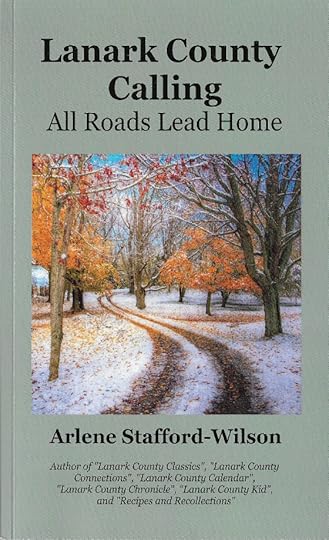Arlene Stafford-Wilson's Blog
September 8, 2025
Perth Writer’s Festival 2025

Perth Writer’s Festival 2025
On a cool overcast September morning a group of authors gathered together in the picturesque town of Perth to share their stories, showcase their books and meet with the public. It’s difficult to imagine a more scenic spot for the 2025 Perth Writer’s Festival than in a location nestled among the talented local vendors in the Crystal Palace at the Perth Farmer’s Market. With the peaceful Tay River meandering faithfully beside us, we were surrounded by over two centuries of history, in one of the most memorable and charming towns in Eastern Ontario.
Tay River
In this idyllic setting along these shores we are reminded of the early days when Perth was founded and of the dreamers and optimists who arrived from faraway shores, transporting their goods up and down this venerable old river.

Mammoth Cheese
Not far from the Crystal Palace stands a reminder of one of the town’s proudest achievements – the replica of the famous Mammoth Cheese. This 22,000 pound beauty was created from milk produced on local farms and the finished product was displayed at the World’s Fair in Chicago in 1893.

Farmer’s Market
As the vendors set up their stands anticipating a busy morning ahead we admired the tremendous variety of local fruits and vegetables, handsome crafts, and unique handmade goods, produced with hard work, care, and proudly displayed.
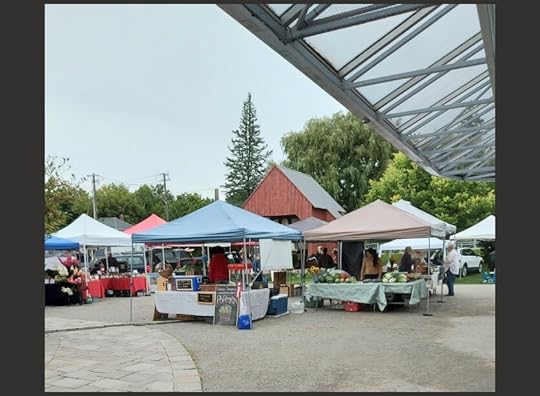
Vendors at the Farmer’s Market
A feast for the senses, some vendors featured fresh bread, honey and pure Canadian maple syrup! A reminder to all that Lanark County is the ‘Maple Syrup Capital’ of Ontario.
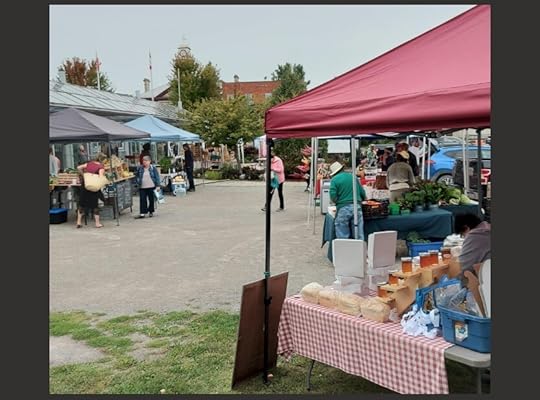
More Market Vendors
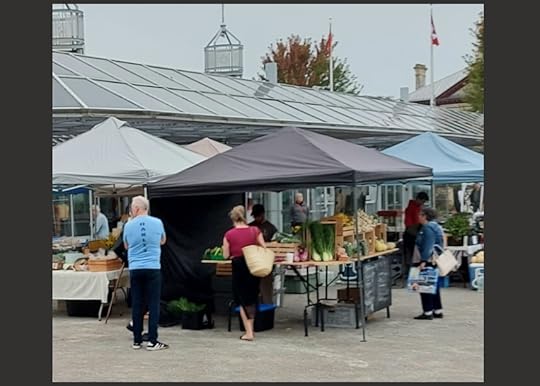
Authors
All of the authors participating in the Writer’s Festival were seated with spacious individual tables to display our books. Sarah Mackenzie, our host and one of the organizers of the event, welcomed everyone warmly to the Crystal Palace. Despite grey skies in the morning and some very brief showers, the event was bustling with shoppers and book-lovers visiting throughout the morning. Many books were signed by authors and carried home by new owners, and a number of interesting visitors and conversations made the day lively and enjoyable.

Author Talks
Conversations flowed easily between Gary Waterfield, our Master of Ceremonies, and the authors present at the event. Gary is a natural with his intuitive interviewing skills and he helped to make everyone feel at ease during this interesting morning segment of the event.
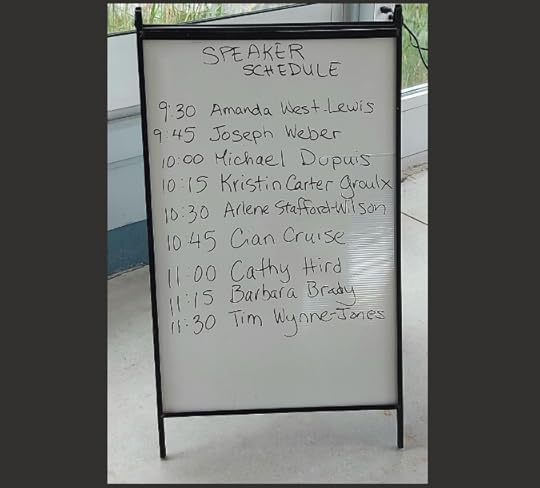
Author Discussions
Gary and I discussed the upcoming book release for “Lanark County Mansions: Spectacular Homes and Fascinating Families”, the 13th book in the Lanark County series.

Afternoon Reception
Although I’m a proud native of this town I never grow weary of scenes like the one below, highlighting the breathtaking beauty of this very historic place.
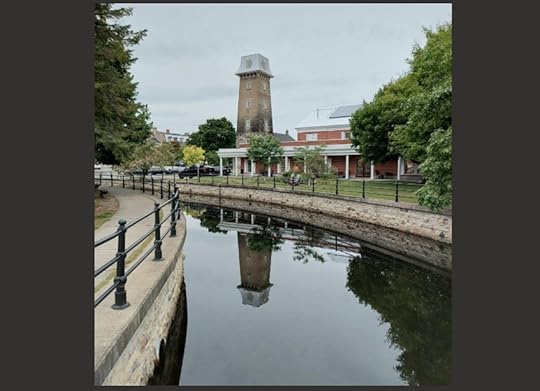
The Library
As we made our way to the Perth and District Union Public Library, the sun beamed from behind a cloud, right on cue, shining a warm and welcoming light as we entered this very special place to meet with our host, Emily Fournier.
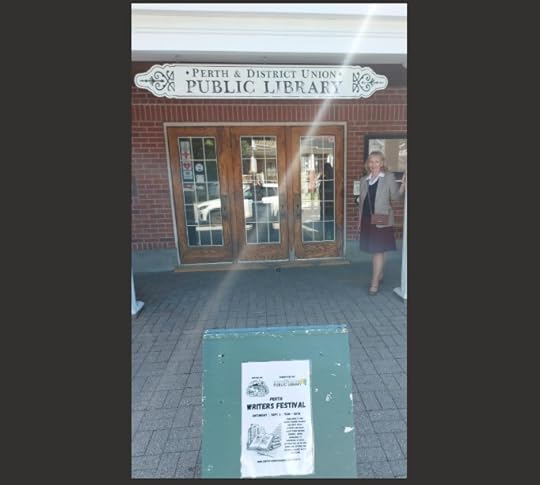
We had the opportunity to chat and mingle with other authors and a bountiful table laden with fresh fruits, savories, and sweets, along with some hot drinks, kindly provided by the Perth Library and Perth Farmer’s Market.
* * *
Thank-you!
A big thank-you to the organizers! – Sarah Mackenzie of the Perth Farmer’s Market and Emily Fournier, of the Perth and District Union Public Library and to Emcee, Gary Waterfield, for all of their efforts and dedication in making this such a successful event.
* * *
Lanark County Mansions – Sat. Sept. 20th, 12 noon – 3 p.m. at The Book Nook
All are welcome to join us at the book launch for “Lanark County Mansions: Spectacular Homes and Fascinating Families, on Saturday, September 20th from 12 noon until 3:00 p.m., at The Book Nook and Other Treasures, 60 Gore Street E., Perth, Ontario. To reserve a copy/pre-order, call 613-267-2350.
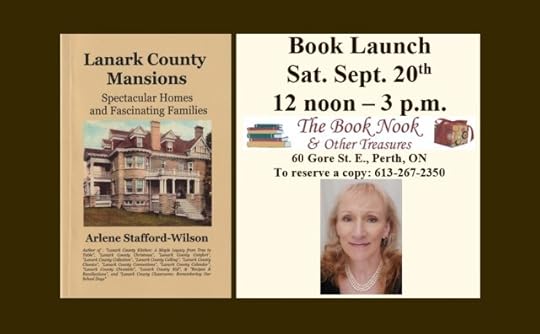
“Step inside a world of incredible wealth where prominent families enjoy the finer things, residing in some of the most magnificent residences in Lanark County. Meet the people who lived in these palatial estates and discover their triumphs, their tragedies, and even some shocking scandals. Learn the closely guarded secrets of these business barons, politicians, and distinguished members of the social elite, as they lived their lives in a Lanark County mansion.”
Arlene Stafford-Wilson
Honorary Life Member, Lanark County Genealogical Society
Lanark County Pioneer Families Humanitarian Award
Francois Bregha Storyteller Award
Heritage Perth Architectural Conservation Award
Member, Association of Professional Genealogists
Author of : “Lanark County Kitchen: A Maple Legacy from Tree to Table”, “Lanark County Christmas”, “Lanark County Comfort”, “Lanark County Collection”, “Lanark County Calling”, “Lanark County Classics”, “Lanark County Connections”, “Lanark County Calendar”, “Lanark County Chronicle”, “Lanark County Kid”, & “Recipes & Recollections”, and “Lanark County Classrooms: Remembering Our School Days”
September 4, 2025
Balderson’s Grisly Murders
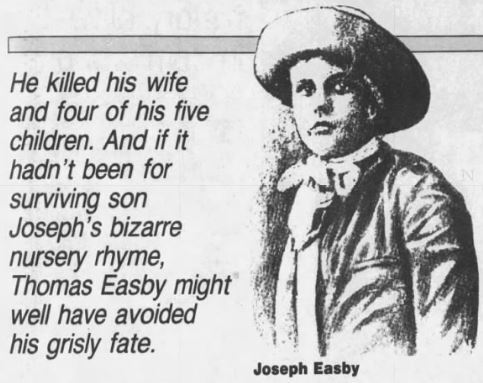
December 10, 1828
near Balderson, Ontario
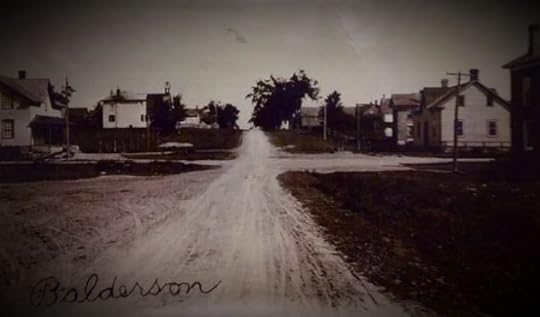
On a cold, dark, December night, right around midnight, Sinclair Tullis’ mother woke to a blood-curdling scream coming from the direction of their neighbour, Thomas Easby’s house. She sent her son to investigate and he could see that the Easby home was engulfed in flames, and heard his neighbour’s voice call out, “Who is there?”
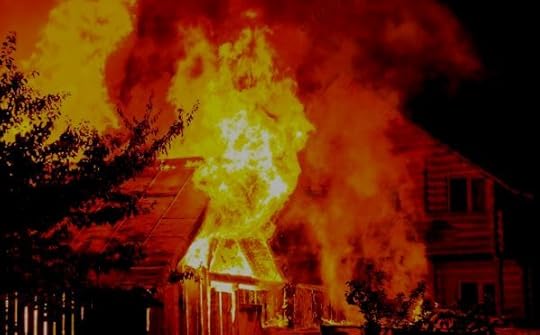
Tullis asked him what happened, and Easby replied, “Go home. The fire is under control. I will be awake until morning.”
When Tullis returned the next morning Easby told him that all of his family had burned to death except his youngest son, Joseph, who sat quietly on the ground, not far from his father. Thomas’ wife, who was eight months pregnant, their daughter, and three sons, were all dead.

Mrs. Martha Richardson, a neighbour, volunteered to look after young Joseph Easby, age four, and although, understandably he was still in shock, she found that he was doing some very odd things. He often sang morbid songs while he was playing, “Father killed mother, sister, and three brothers.” Mrs. Richardson found these songs quite disturbing, as well as some of the games he played. Sometimes he would point to the handle of their shovel and claim that his father had struck his mother with one just like it. He also played a game where he pretended to cover his dead siblings with hot coals.
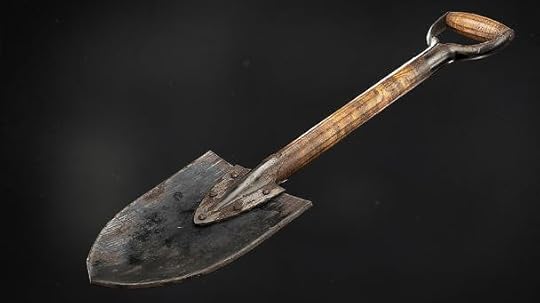
After a few weeks, when Christmas had past, and young Joseph continued to play the strange games, and sing the shocking songs, she informed her neighbour, Sergeant John Balderson, a former infantry soldier. He began to make inquiries and spoke with some of the legal officials in Perth about the young lad’s odd behaviour.
In February two magistrates, along with Dr. James Wilson and Coroner William Matheson went to speak with Thomas Easby and grew suspicious after he gave them his explanation of what happened that fateful night. They ordered an exhumation of Easby’s wife and children, and an examination was done by Dr. Wilson, who determined that Mrs. Easby’s skull was fractured in five places, and the children’s skulls also showed signs of blunt-force trauma. Easby could not explain how these injuries happened.
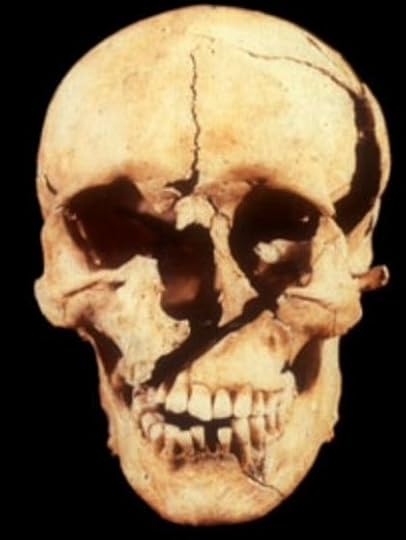
The following day, John Balderson, Dr. Wilson, and the local Jailer, James Young, told Easby that his family had been murdered. Easby began to cry, and said that he’d killed them all with a thick branch from a Birch tree. He insisted that he had only intended to kill his youngest child, Joseph, but that the child had looked up at him and smiled, and so he killed all of the others instead.
The Trial
At his murder trial, Easby addressed the court, “I was in a perplexed and insensible state of mind at the time of the murder and had only a faint recollection of what occurred. I seemed to have no power of myself, no volition of my own. But, I was impelled to the act by some mysterious agency, which entered my abode and appeared to assist me. After the dreadful tragedy I called some of my family by name, and discovered what I had done, and I exclaimed to myself, “Oh! My God, I have murdered them.”
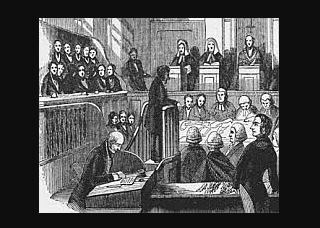
The trial judge, Chief Justice Sherwood, after pronouncing Easby guilty, declared, “Your days are numbered, your mortal course is finished.”
Easby was hanged on November 13, 1829, before the largest crowd ever gathered in Perth, Ontario. Local newspapers praised the skill of the hangman in his execution of the guilty man.

Easby’s body was buried in the Anglican section of the Craig St. cemetery, but later that same night, his remains were exhumed and delivered to the local surgeon and his medical students for the purpose of dissection. According to “The Perth Courier”, “They first skinned the body, and the hide was rolled in salt and afterwards tanned in a local tannery and cut up into small squares, which were sold to the public, bringing as much as two dollars.”
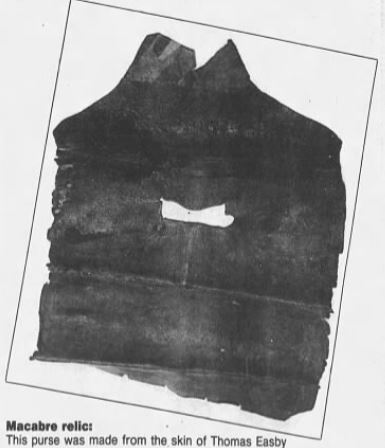
In the 1980s, a reporter from “The Perth Courier”, Michael Taylor, decided to search the area for anyone who might still be in possession of Easby’s skin. Eventually, he located Mrs. George Smith, of Balderson. She had made a purse from Easby’s hide. Another area resident, Alex Balderson, had a strip of the ‘Easby leather’, and had made it into a bookmark. He claimed that it was kept in an old family bible. In faded ink, on the back of the bookmark there was a quote from the Bible, “Whoever strikes a man so that he dies shall be put to death.”
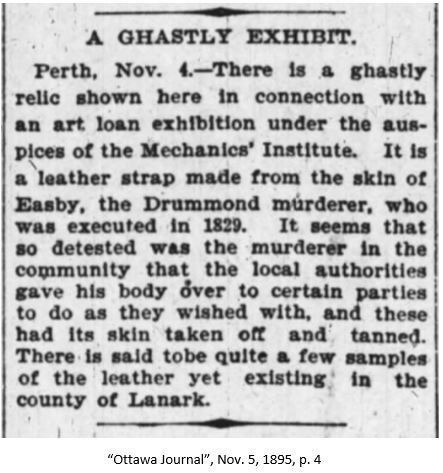
Hide was Sold
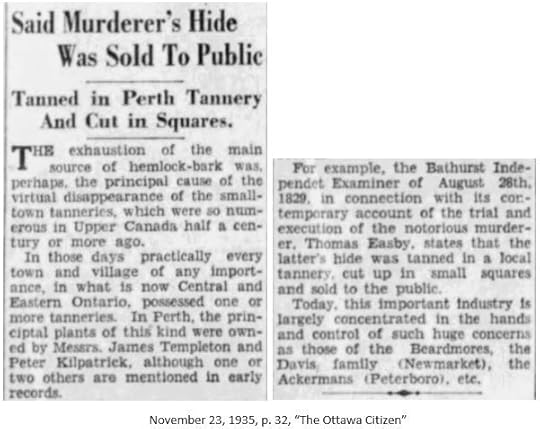
Jail Employees Recall
Stories of Easby
It’s been said that of all the convicted criminals who were hanged in Perth, Thomas Easby was perhaps the most notorious. When it was announced in the summer of 1994 that the Perth jail was closing, “The Ottawa Citizen” sent a reporter, and the employees recalled hearing the stories of Easby’s hanging.

According to one of the workers at the Perth jail, “He (Easby) was kept in the original Perth Jail for several months before he was publicly hanged, the rope adjusted with great dexterity in front of a huge crowd of townspeople. Then his body was dug up, skinned, and tanned, and the bits were sold off and made into wallets and knick-knacks.

Chuck Stewart, the Superintendent, said that many more people were hanged over the years in Perth, and that the last hanging was in 1910, at the permanent gallows, at the back of the jail. The noose hook has since been covered by a light fixture, and the lever which activated the trap door in the floor has been removed. In its place is a chair on the wooden floor overlooking the exercise yard.
“Murder, as foul as it comes.”
When asked about the future of the jail, Stewart said the cells and prisoners’ areas are tiny and the plumbing and electrical systems are a nightmare. There are rumours of turning it into a bed and breakfast, but according to Stewart, “Bed and breakfast people don’t like sleeping in cells.” Ottawa Citizen Reporter, Kelly Egan, added, “…and who would rest easy on the ground where Thomas Jeremiah Easby met his gruesome end, for murder as foul as it comes.”
What Became of
Little Joseph Easby?
And what became of young Joseph Easby, orphaned at the age of 4, and the only surviving member of his family? In a letter dated in 1857, regarding the estate of Joseph Easby, he had drowned at age 32, unmarried, after falling from a ship in the Toronto harbour.
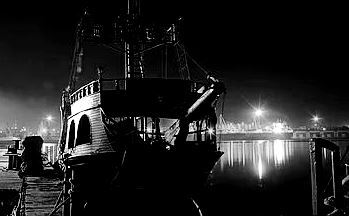
In the small community of people who lived around Balderson, the story of the tragedy that took place at the Easby farm was told and re-told down through the generations; and although they are fewer in number these days, some still claim to possess items fashioned from the hide of Thomas Easby.
Anyone who has visited the pretty hamlet of Balderson, and knows their long history and stellar reputation for cheese-making, would no doubt be surprised to learn of the gruesome and grisly events that took place at the Easby house, on that dark, cold, winter’s night in 1828.
* * *
Further reading: A book was published in 1903, written by Robert L. Richardson, the grandson of Martha and Thomas Richardson, who cared for little Joseph Easby, until he was adopted and raised by a couple in Toronto. His book, “Colin of the Ninth Concession”, was loosely based on the Easby murders.

Arlene Stafford-Wilson
Honorary Life Member, Lanark County Genealogical Society
Lanark County Pioneer Families Humanitarian Award
Francois Bregha Storyteller Award
Member, Association of Professional Genealogists
Heritage Perth Architectural Conservation Award
Author of: “Lanark County Kitchen: A Maple Legacy from Tree to Table”, “Lanark County Christmas: Memories of a Yuletide Past”, “Lanark County Comfort”, “Lanark County Collection”, “Lanark County Calling”, “Lanark County Classics”, “Lanark County Connections”, “Lanark County Calendar”, “Lanark County Chronicle”, “Lanark County Kid”, “Recipes & Recollections” and “Lanark County Classrooms: Remembering Our School Days”.
New – Fall 2025
“Lanark County Mansions: Spectacular Homes and Fascinating Families”
“Step inside a world of incredible wealth where prominent families enjoy the finer things, residing in some of the most magnificent residences in Lanark County. Meet the people who lived in these palatial estates and discover their triumphs, their tragedies, and even some shocking scandals. Learn the closely guarded secrets of these business barons, politicians, and distinguished members of the social elite, as they lived their lives in a Lanark County mansion.”
Book Launch: Saturday September 20th, 12 noon – 3 p.m. at The Book Nook and Other Treasures, 60 Gore Street E., Perth, Ontario, Canada
To reserve a signed copy/pre-order call: 613-267-2350
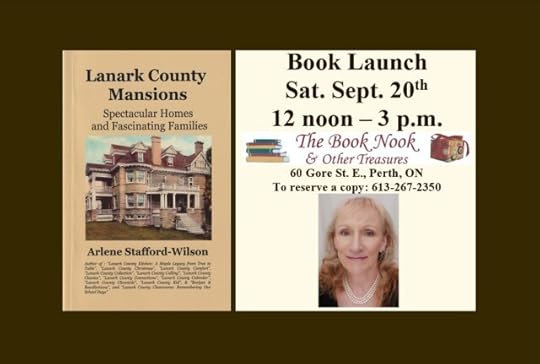
September 2, 2025
Lanark County Mansions: Book Review Hometown News
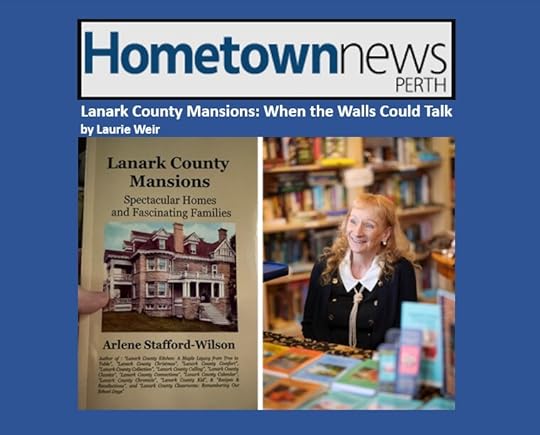 Book Review by: Laurie Weir
Book Review by: Laurie WeirLANARK COUNTY — Behind the elegant stonework and stately verandahs of Lanark County’s grandest homes lies a swirl of romance, tragedy, and scandal. That’s the story local historian Arlene Stafford-Wilson uncovers in her latest book, Lanark County Mansions: Spectacular Homes and Fascinating Families.
This is Stafford-Wilson’s 13th book in her Lanark County series. She grew up on a small farm in the county, is an honorary life member of the Lanark County Genealogical Society, and in 2024 received the Perth Heritage Architectural Conservation Award for her archival work. Her research doesn’t just document the past, it animates it.
The scope in this book is sweeping. From the McMartin House in Perth to the Caldwell Mansion in Lanark Village, from Carleton Place’s Burgess Mansion to Almonte’s Thoburn home, and even the Gile Mansion in Smiths Falls, Stafford-Wilson profiles these landmark buildings and the families who lived there: the Burgesses, Caldwells, Thoburns, Codes, McIntoshes and many more.
To show just how alive these stories feel, I’ve paired each mansion’s tale with a playful “real estate listing” blurb. The twist highlights how Stafford-Wilson’s storytelling makes these heritage homes read like properties with character, and baggage, you won’t find on MLS.
In Smiths Falls, Glenwood Mansion at 22 Chambers St. rose as a symbol of industrial wealth. Alexander Wood, of Frost & Wood farm implements, “spared no expense designing his magnificent home and it truly was a reflection of his wealth and stature in the community” (p. 48). Its grand ballroom dazzled, but the ending was dark: “A gasoline fueled fire-bomb destroyed the historic Wood mansion and resulted in the loss of life of four residents” (p. 50).
Listing blurb: Three storeys of sandstone elegance, ballroom included. Comes with one of the most notorious arson cases in Smiths Falls history.
Then there is Perth’s Kininvie Mansion, at 50 Herriott St. This Edwardian dream home was built in 1906 by Thomas Alfred Code for his wife Jennie. Stafford-Wilson writes, “Touched by both romance and tragedy, the architectural splendour of this Edwardian beauty continues to delight onlookers today” (p. 68). Tragically, Jennie passed away just a year later.
Listing blurb: Six fireplaces, manicured lawns on the Tay River, steam heat piped from Code’s Mill. Comes with one great romance, and one heartbreak you can’t renovate away.
Almonte’s Thoburn Mansion, at 161 Union St., tells a different story. Completed in 1887, it was “considered one of the most impressive residences in town” (p. 121). William Thoburn parlayed his flannel mill fortune into politics, serving as mayor and later as a Member of Parliament. The home’s lavish weddings, Stafford-Wilson notes, were “the talk of the town” (p. 123).
Listing blurb: Two-and-a-half storeys, hot-water heating ahead of its time, and a ballroom that doubled as a campaign office. Comes with political aspirations built right into the walls.
And then there’s Carleton Place’s Burgess Mansion, at 249 Lake Ave. E. is easily the most scandal-filled of the lot. Stafford-Wilson writes, “This family seethed and fumed together in an angry cauldron under the stately roof of the Burgess mansion” (p. 15). With contested wills, political feuds, marital breakdowns, and whispers of affairs, it became a stage for public drama.
Listing blurb: Brick elegance, circular driveway, dining room for 50 guests. Price includes generations of family feuds, contested estates, and enough gossip to keep the neighbours busy for a century.
That’s the brilliance of Stafford-Wilson’s storytelling. She does more than catalogue architecture. She resurrects the people who built and occupied these houses; the fortunes, politics, and secrets that shaped Lanark County itself.
And for local readers, there’s another draw: the appendix of names. Stafford-Wilson includes families in this book from Adams to Wylie. For anyone with local roots, this book doubles as a genealogical treasure hunt.
It’s the kind of book you’ll want to linger over. Which brings me to this: how do you love your books? Do you keep them pristine, never bending a corner or cracking a spine, the kind of reader my mother admires? Or are you like me, folding pages, scribbling notes, highlighting lines so you can come back to the juicy bits? My mother would call that monstrous, but I call it living inside the pages.
Lanark County Mansions almost begs for that kind of reading. There are many stories you’ll want to return to, whether it’s the grand romances, the whispered scandals, or the tragedies that echo in stone. Whether you treat your books with kid gloves or dog-ear the corners, this is one worth keeping close at hand.
Stafford-Wilson will launch her book on Saturday, Sept. 20 at The Book Nook and Other Treasures, 60 Gore St. E. in Perth, from 12 to 3 p.m. It’s a chance to meet the author who has spent decades proving that the walls of Lanark’s old homes do more than stand — they speak. Have a listen.
* * *

* * *
Link to full review in, “Hometown News”
Lanark County Mansions: When the walls could talk
Arlene Stafford-Wilson
Honorary Life Member, Lanark County Genealogical Society
Lanark County Pioneer Families Humanitarian Award
Francois Bregha Storyteller Award
Heritage Perth Architectural Conservation Award
Member, Association of Professional Genealogists
Heritage Perth Architectural Conservation Award
Author of : “Lanark County Kitchen: A Maple Legacy from Tree to Table”, “Lanark County Christmas”, “Lanark County Comfort”, “Lanark County Collection”, “Lanark County Calling”, “Lanark County Classics”, “Lanark County Connections”, “Lanark County Calendar”, “Lanark County Chronicle”, “Lanark County Kid”, & “Recipes & Recollections”, and “Lanark County Classrooms: Remembering Our School Days”
August 28, 2025
Ompah Stomp!
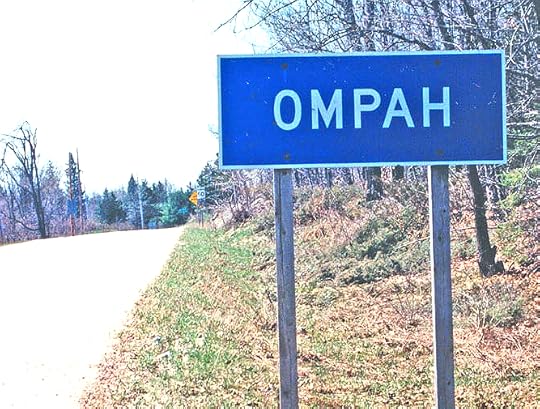
“Drivin’ country roads, highway 509,
August sun is shinin’, and we’re feelin’ fine,
Been workin’ real hard, and we need a little break,
Headin’ for the party up at Palmerston Lake
Grab a bottle, twist the cap, and pass it around,
Swayin’ with my baby to the country sounds,
Music’s loud, fool around, go for a romp,
This is how we do it at the Ompah Stomp”
Arlene Stafford-WilsonThe Ompah StompIt was late August, 1978, when we heard about a music festival, to be held over the Labour Day weekend, in Ompah. This was going to be a back-roads tour, to end all back-roads tours – an outdoor party with live music, and we couldn’t wait!
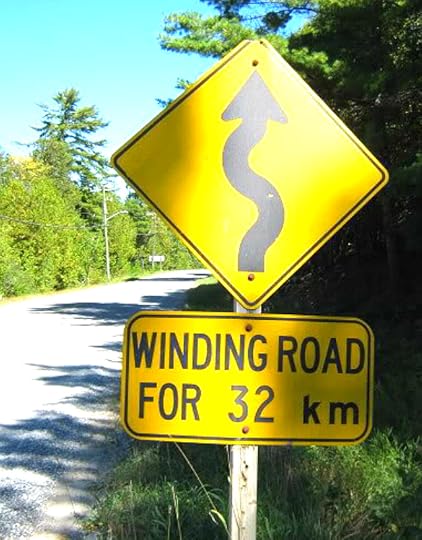
In those days, Ompah was a tiny, quiet, village. The most popular place in Ompah, was the Trout Lake Hotel, owned by Wayne Kearney.
The building was originally a private residence; over 150 years old, in fact it was the oldest building in Ompah. Over the years, the residence became a popular local bar. The old timers around there say that they began serving liquor there in 1904. It was the first licensed establishment in Eastern Ontario, and the locals also claimed that it was one of the first bars in the province.
The hotel was rumoured to have been the setting for some famous and infamous barroom brawls too, but we won’t get into that. The busiest times were in the summer. During the year, there were quiet times, but the seasonal visitors, mostly summer fishing enthusiasts, and the winter snowmobiling patrons, kept it fairly busy.
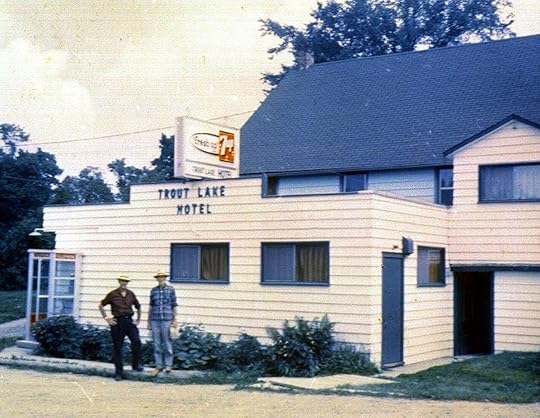
After much anticipation, Labour Day weekend, 1978, finally arrived.
We jammed as many young people that could fit, into one of my friend’s parent’s cars, and off we headed to Ompah. We drove up the Third Line, and turned onto Cameron Side Road, past Calvin Church, over the railroad tracks, and onto Hwy 7. We turned onto the Elphin Maberly Road, and continued onto Hwy 509, then Lake Road, and Lafolia Lane. The Stomp grounds were beautiful, green, and lush, with tall, majestic trees, situated on a hill, overlooking scenic Palmerston Lake.
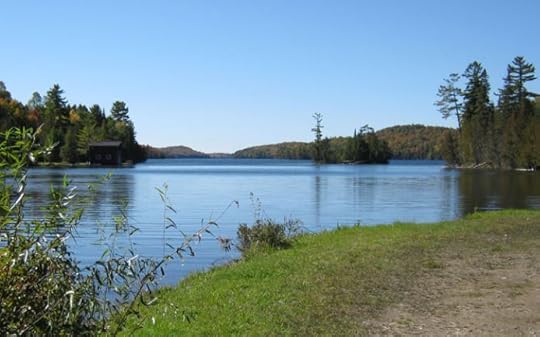
That first Ompah Stomp, was held on September 3, 1978, and their special guests were Max Keeping, of CJOH TV, and Doug Anderson of CKBY FM. There was a step dancing contest, held at about 8 p.m., followed by old fashioned round and square dancing. The musical guest artists that year were Sneezy Waters, Mike O’Reilly, and Wayne Rostad.
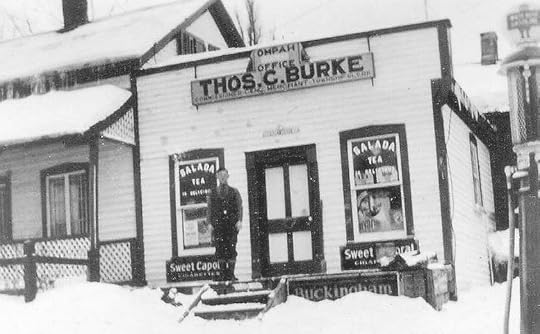
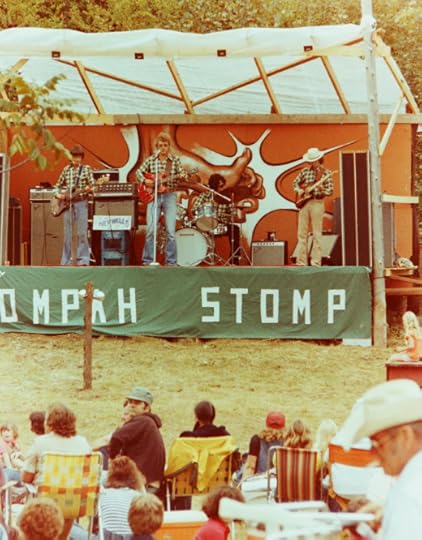
Over the years, we grew to believe, that this annual country music festival, was our own little ‘Woodstock’. The Ompah Stomp became legendary, growing in leaps and bounds, as people heard about it, and wanted to experience the live music, and wild party atmosphere.
That first year, in 1978, the organizers had anticipated about 200 people attending, and the total numbers were closer to 3,500. The second year, the crowds grew to 5,000 and the third year, saw the attendance numbers rise to 6,500.
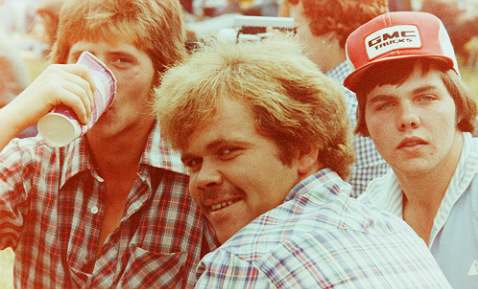
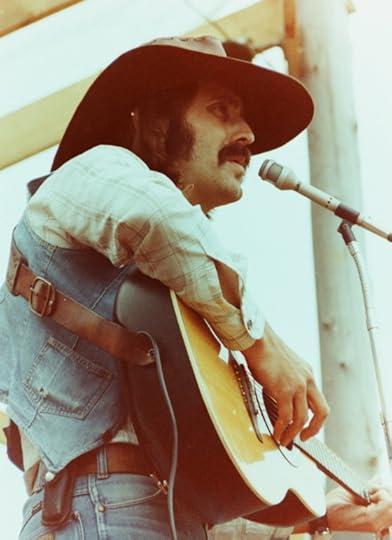
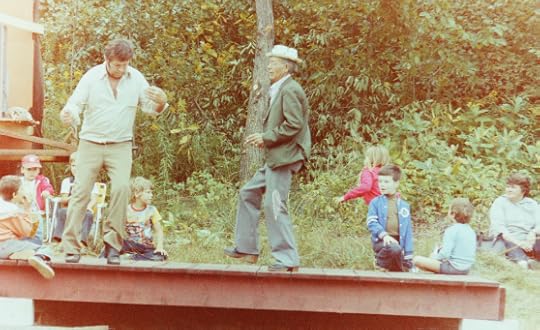
Some of the musical acts that performed at the Stomp were: Neville ‘Nev’ Wells, , the Family Brown, Jack McRae and the King of Clubs, The Prescott Brothers, Hugh Scott, Ron McMunn and Carbine, Steve Glenn, David Thompson, Fred Dixon, Lynn and Chris, Lloyd Wilson, Dallas Harms, Ted Daigle, C-Weed Band, Terry Carisse and many others.
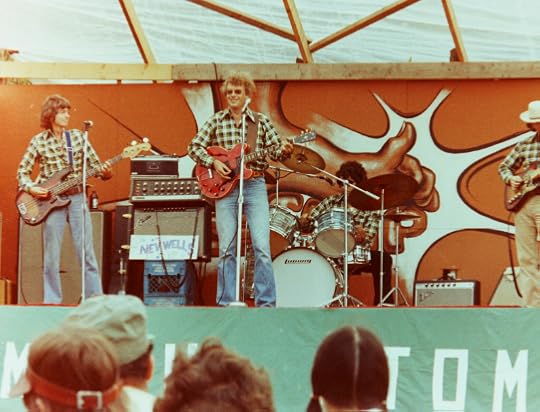
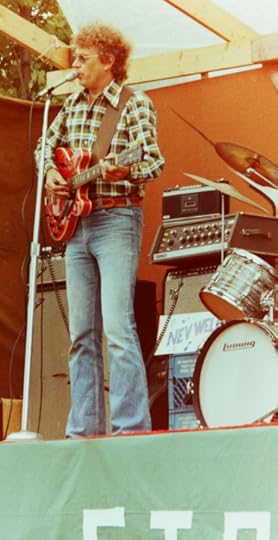 Guitar: Neville Wells
Guitar: Neville Wells
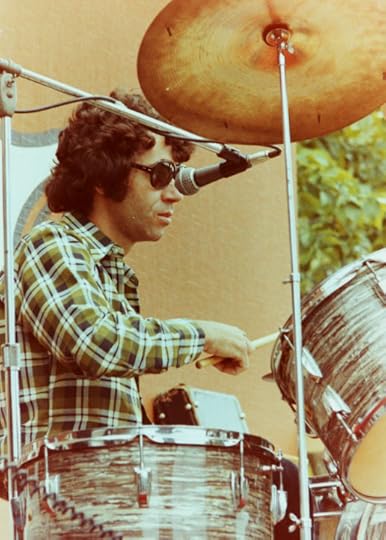

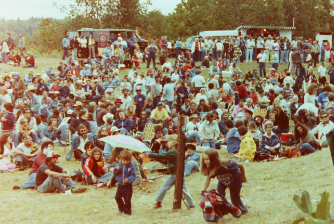
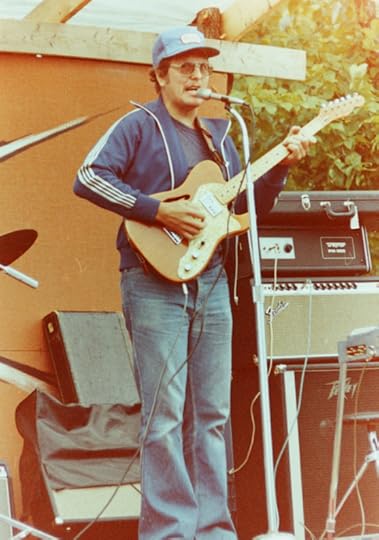
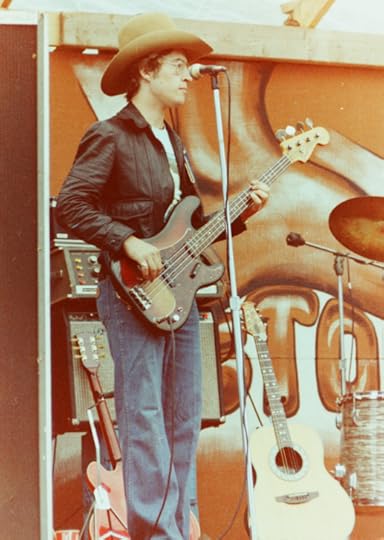
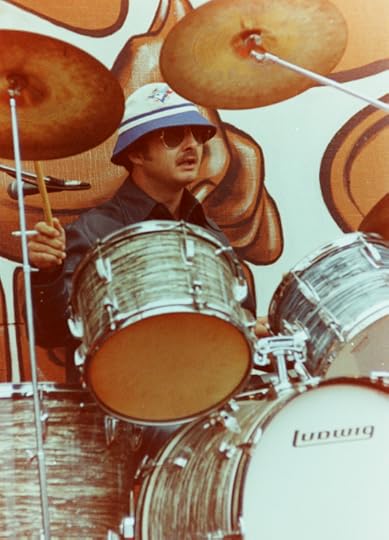
“Perth Courier” September 12, 1979 – a review of the second year of the ‘Stom p’:
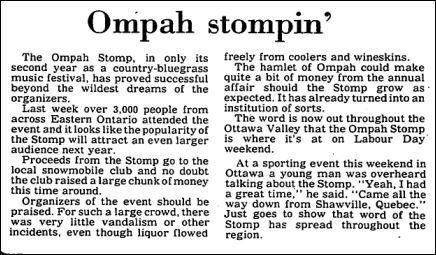


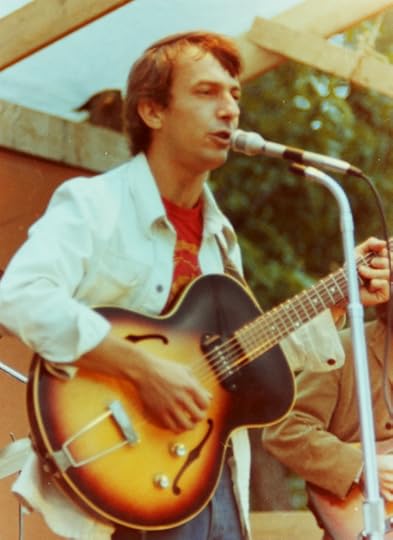 Sneezy WatersA poem written by Kathy Norwood, about the ‘Stomp’, printed in March 1980
Sneezy WatersA poem written by Kathy Norwood, about the ‘Stomp’, printed in March 1980
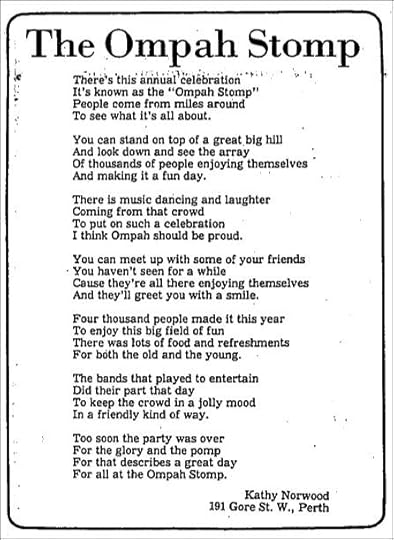
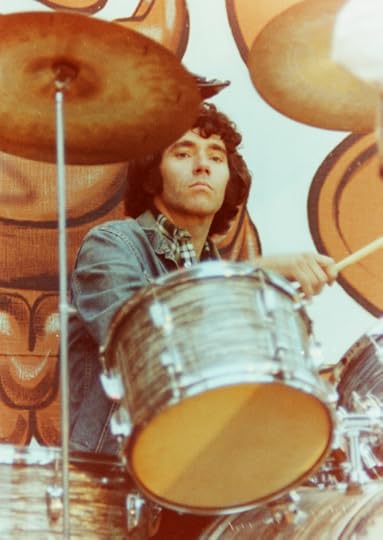

The Ompah Stomp became a much-anticipated annual event, and was featured in the local newspapers.
“Perth Courier” Sept. 2, 1981, page 19:
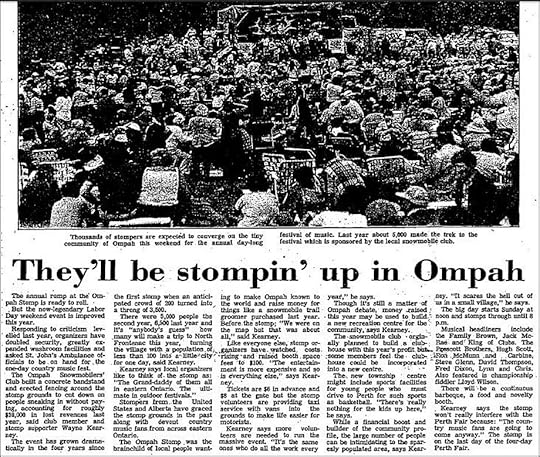

* * *
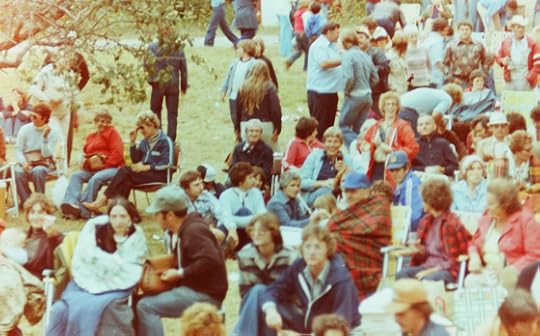
The Road to ‘The Stomp’ – 1983
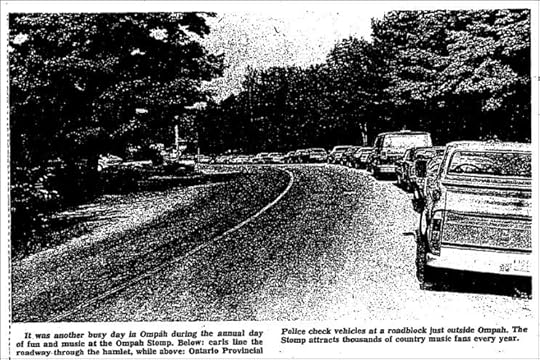

Liquor and beer flowed freely from coolers and wine-skins, and the lineup at the washroom facilities was unbelievably long, but everyone enjoyed themselves just the same. In those days, if we wanted to hear live music of that caliber, we had to travel to Ottawa or Kingston, so it was amazing to have the Ompah Stomp so nearby.

As the years passed by, the Ompah Stomp gained an infamous reputation as being a very wild party, and the local police adopted stricter controls for the festival.
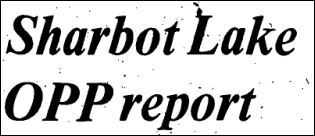
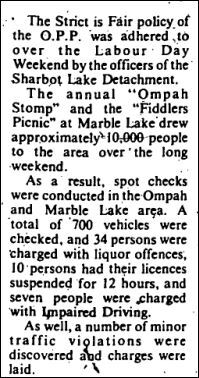
The Stomp carried on for many years, after those first few annual celebrations. Visitors traveled from the U.S., and from neighbouring provinces as well.
Labour Day weekend was one of the busiest and most exciting times for us, in the area.
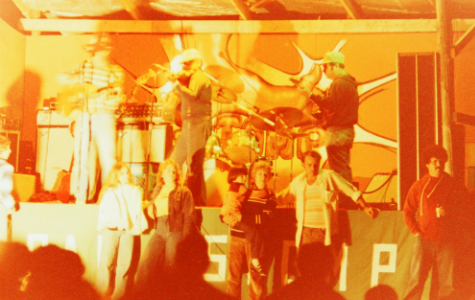
Looking back, it’s difficult to imagine that a tiny village of around 100 people, and their local snowmobile club, could create a music festival, attracting thousands of people, from all around.
The Ompah Stomp was a shining example of the spirit of the people in rural Eastern Ontario, and what they could accomplish. They never faltered in their belief that they could succeed, or lacked the confidence to organize a music festival just because they were a small handful of folks, from a tiny village.
The Ompah Stomp became a metaphor, an example for all of us, that it only takes a few people who believe strongly in something to make a difference.
I will always remember those special times at the Ompah Stomp, and how they made the final weekend of summer something we’d all remember fondly for years to come.
…
Special Thanks!Photos from the 1978 Ompah Stomp from the private collection of Don White, from the band, Grateful We’re Not Dead: Grateful We’re Not Dead Facebook Page
Many thanks to Don White and Neville Wells for providing the names of the musicians in the photos!
Neville Wells, a founding father of the ‘Ompah Stomp’, was inducted into the Ottawa Valley County Music Hall of Fame, in 1994.

For more information on Grateful We’re Not Dead: Grateful We’re Not Dead Official Band Website
……..
Some of the families who settled around Ompah: Dunham, Kelford, Closs, Conlon, Dawson, Ellenberger, Elliott, English, Gunner, Hitchcock, Cox, Keller, Killlingbeck, Kirkwood, Mabo, Massey, McGonigal, McDougall, Molyneaux, Moore, McDonald, Murphy, Payne, Praskey, Sproule, Thomas, Tooley, Richardson, Riddell, Roberts, Sproule, Stewart, Stinson, Thomas, Uens, Ostler, MacRow, Martelock, James, Ackerman, Allen, Struthers, Brown, Gunsinger, Lemke, Armstrong, Jeannerett, Hermer, McNeil, Badour, Johnston, Kring, HIll, Weiss, Wood, Card, Boyd, Dempster, Donaldson, Larock, Morrow, Mundell, Praskey, Ryder, Shanks.
…
Why Did the Ompah Stomp end? Find out the real reasons behind the final days of the Ompah Stomp, from the people who were there…Discover the ‘glory days’ of the Ompah Stomp, how it began, who was there, the unforgettable parties, the music, and more:
“The Legendary Ompah Stomp”, in the book –
“Lanark County Calling: All Roads Lead Home” ISBN: 978-0-9877026-61
* * *
Arlene Stafford-Wilson
Honorary Life Member, Lanark County Genealogical Society
Lanark County Pioneer Families Humanitarian Award
Francois Bregha Storyteller Award
Heritage Perth Architectural Conservation Award
Member, Association of Professional Genealogists
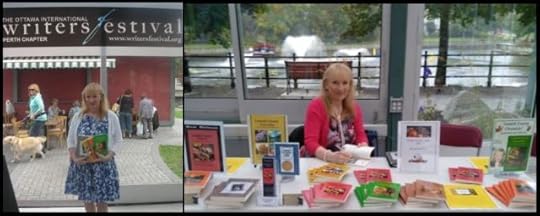
Author of : “Lanark County Christmas”, “Lanark County Comfort”, “Lanark County Collection”, “Lanark County Calling”, “Lanark County Classics”, “Lanark County Connections”, “Lanark County Calendar”, “Lanark County Chronicle”, “Lanark County Kid”, & “Recipes & Recollections”, “Lanark County Kitchen: A Maple Legacy from Tree to Table”, “Lanark County Classrooms: Remembering Our School Days”.
New Release Fall 2025
“Lanark County Mansions: Spectacular Homes and Fascinating Families” – $25.99

“Step inside a world of incredible wealth where prominent families enjoy the finer things, residing in some of the most magnificent residences in Lanark County. Meet the people who lived in these palatial estates and discover their triumphs, their tragedies, and even some shocking scandals. Learn the closely guarded secrets of these business barons, politicians, and distinguished members of the social elite, as they lived their lives in a Lanark County mansion.”
To reserve a signed copy/pre-order: Call The Book Nook at 613-267-2350
Book Launch: Saturday, September 20th from 12 noon until 3 p.m. at 60 Gore St. E., Perth, Ontario
August 27, 2025
Memories of the Perth Fair
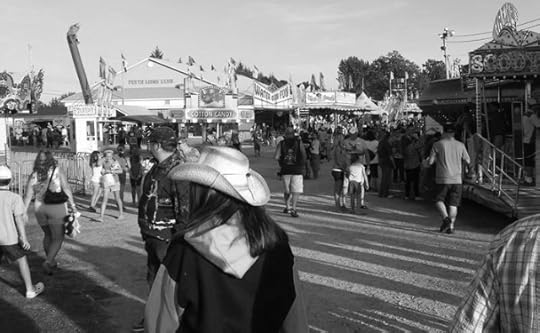
It wasn’t just our Mother who loved the Perth Fair. Yes, she spent months preparing for those brief few hours each Labour Day weekend, at the fairgrounds, along Rogers Road, but the rest of the family also felt a sense of excitement, rivalled only by Christmas morning!

We would drive into Perth, park at our Aunt Pat and Uncle Peter Stafford’s house at 48 Halton Street, walk up the street, and enter the gates. By the time we got to the entrance, and Mother showed her Exhibitor’s Pass, we were bursting with anticipation. I knew that Mother would be heading straight for the Homecraft Building to check on her entries, but instead, I always chose to slow down, look around, and take it all in.

Mother always glanced back, waved, and then rushed down the well worn path, through the midway, and up to the buildings. I stood with my back against the side of the Lion’s Hall, and glanced around. There was so much to see that I didn’t know where to look first. Being a kid, my eyes naturally gravitated toward the rides.
The Rides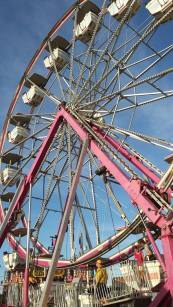

They were all spinning and whirring, and the bright sun was bouncing off of all of the shiny metal. There was a Ferris wheel, a Scrambler, a Tilt-a-Whirl, and the Bullet. The Swings took up a lot of room, and so they were set up to the right of the buildings. I could see four kiddy rides: a Merry-Go-Round, Baby Airplanes going round in a circle, Ladybugs, and a Little Red Caboose making its way along a tiny round track.
The FoodOnce my eyes had taken in the rides, my senses turned to all of the sweet aromas of the Fair. Right across from where I was standing was the Lion’s Club Ladies’ Booth, and I could smell their fresh, homemade hamburgers, and the savory scent of fried sweet onions. Straight ahead of me, just past the entrance was a vendor swirling a paper funnel around and around, in a circle, pink cotton candy swelling out from the stick, as he twirled it inside the machine.
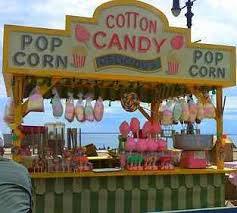
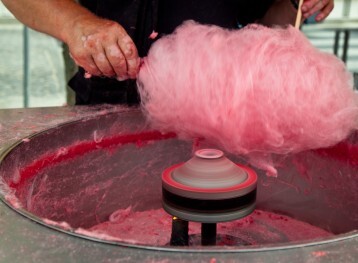
Next to the cotton candy stand, was a man selling corn on the cob, and several people were waiting in line. Folks were holding their cobs by a short wooden stick that had been plunged right into the big end of the cob, and there were two or three separate unwrapped pounds of butter set on the edge of the counter of the vending cart. The butter had already taken on a curved shape as people spun their cobs, and then salted them.
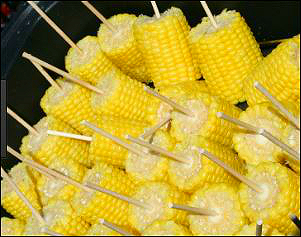

Next to the corn vendor was the hot dog cart. A tall, lanky man was grilling hot dogs on one side, and the finished dogs were spinning slowly around glistening on the grill. On the other side of the wagon, a younger lad was piercing hot dogs with long slender sticks, dipping them in batter, and placing them into a big deep fryer. The cart had a low shelf with mustard, ketchup and relish and some diced onions for people to dress their hot dogs.
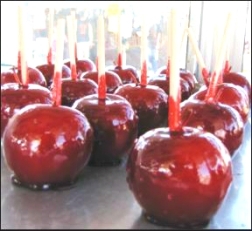
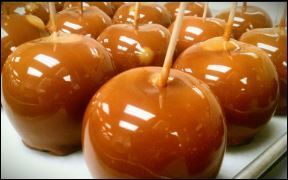
There were two more food carts, so I strolled a bit farther down the midway toward the buildings. The first cart held a popcorn machine, even bigger than the one that I’d seen at the Soper Theatre in Smiths Falls. It was a large, metal machine, painted red, and the popcorn was spilling out of the top into a big glass case. The vendor was lifting it out with a bright, silver scoop, and placing it into small white paper bags that were decorated with red stripes and a clown’s face.

The last food vendor in front of the Commerce building, was making snow cones. There was a square, metal and glass machine and an old man in a dirty apron was pouring ice cubes into a big funnel on the top. There were white cone-shaped paper cups stacked in a tall dispenser attached to the side of the machine and when he cranked the handle on the opposite side snow came out of an opening at the front. There were clear plastic squeeze bottles lined up on a shelf, at the front of the machine, and each was labeled with a different flavour: cherry, orange, lemon-lime, grape and blueberry.

I’m not sure if I was really hungry or if it was just from seeing and smelling all of the different kinds of food, and I thought that I might buy either a small bag of popcorn, or a blueberry snow cone. I dug deep into my pocket, and pulled out my money. I had exactly twelve dollars, and my money had to last for the whole weekend, and this was just the first day. I needed to save some, because my friends Susan and Jane Munro, Patti Jordan, and Debbie Majaury, would be coming into town later, and I’d want to go on the rides with them. Because the rides were $1.25 each I had to be careful not to spend money on food, so I stuffed the bills and change back in my pocket, and kept walking, taking in all the sights along the way.
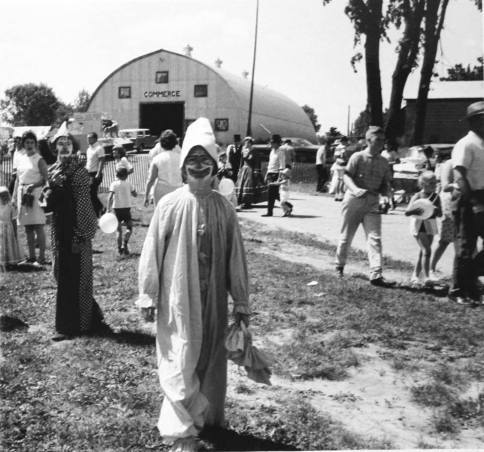
I heard a man’s voice yelling at me, and it startled me so much that I jumped. I looked toward the man timidly, and he was in a game booth, right behind a food cart, and he had a table set up with some wooden milk bottles, stacked in a pyramid. He had a baseball in his hand, and called to me to come and knock over the milk bottles. It scared me so much that I walked away. I wasn’t used to strangers. We knew everyone out on the Third Line of Bathurst, and lots of the folks in Perth as well. None of the people we knew ever yelled at us like that, right out of the blue, and certainly not a stranger. I walked quickly away, not looking back.
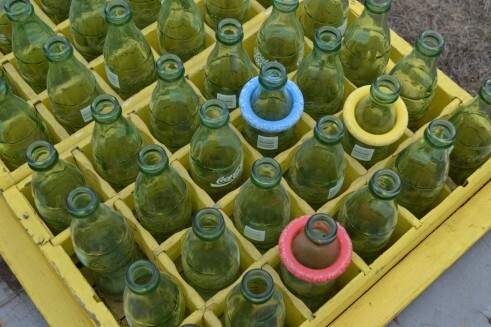
The people that operated the games made me nervous. They had a lot of tattoos, which was something we never saw in those days. Many of them were a bit too aggressive. I’d played some of those games before, and although I won, I didn’t get the big stuffed bears and dogs that were hanging along the top and sides of their booth.
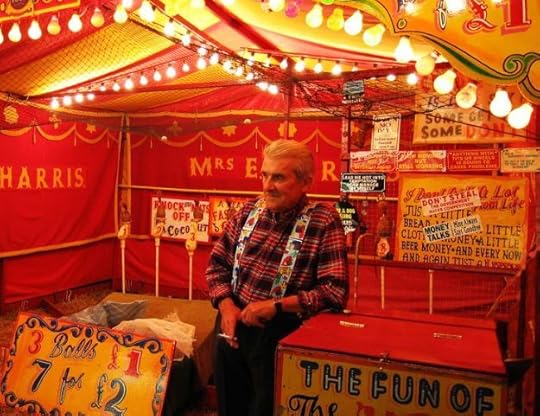
I’ll never forget the first time I played a game. The back wall of the booth had four or five rows of balloons blown up, and they were stuck to the wall. I thought I’d have no problem hitting one of the balloons, so when the man yelled at me to come and play, I thought it would be a sure thing.
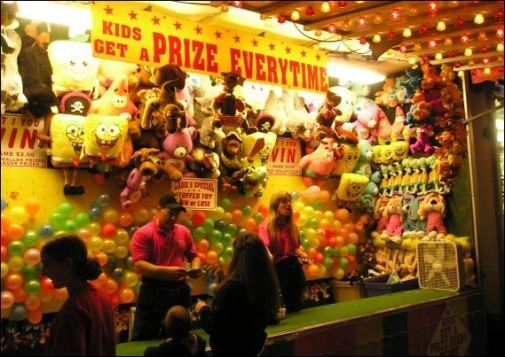
He said it was $1.00 for three darts so I handed him my money, and he handed me three darts. Sure enough, the balloons weren’t that far away, and I hit and burst all three of them.

He reached down under the table, into a big cardboard box, and handed me a mangy looking stuffed snake. It was about six inches long, and had an orange felt tongue, badly stitched onto its mouth, and two black felt eyes, that weren’t even lined up.
Trickery!I looked up at the big stuffed bears and asked him why I hadn’t won one of those. He said that my prize was a ‘small’ and if I wanted a ‘large’ prize I’d have to play and win, trading up to a ‘medium’ then win a certain number of ‘mediums’ and then I’d finally get one of the big bears. Holy cow! Talk about disappointed! What kind of scam was that? Folks from Bathurst Township were used to other people dealing with them fairly. This game seemed like out and out trickery, and I wasn’t very impressed. Still, I didn’t want to tell Mother that I’d just wasted my money, so I kept it to myself. I didn’t even want to tell my friends that I’d been fooled like that. I felt stupid.
I walked by all of the other game booths, and watched people play. Some folks walking around the fairgrounds were actually carrying one of the great big stuffed animals. I wondered to myself how many of those mangy stuffed snakes they’d had to trade up in order to finally claim the big prize.
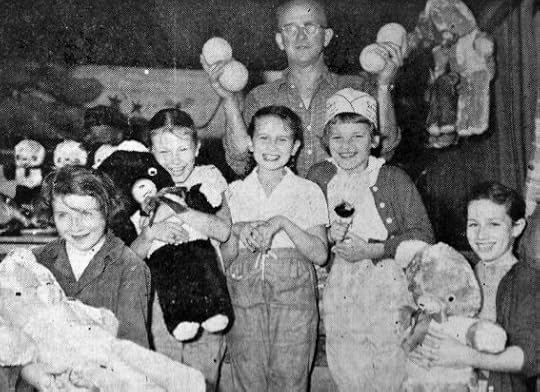
I walked past the last game in the midway, and there was a rough-looking older woman, holding a bunch of short, wooden fishing rods, with small black metal squares on the ends. There was a round aluminum tub of water on the ground, and floating along the surface of the water were dozens of little yellow plastic ducks, and they each had ‘S’, ‘M’ or ‘L’, marked on their heads in black marker – small, medium and large I guessed. I must have been staring too long at the tub of ducks because she called out at me to come and play. She said everyone is a winner. Not to be tricked again, I asked her what the prizes were, and she showed me. She didn’t have huge stuffed animals, but it was only fifty cents to play, and you could fish in the tub until you caught a duck.

I dug into my pocket, and pulled out two quarters, gave them to her, and she handed me a fishing rod. By this time, after watching other folks play for a few minutes, I had figured out that the heavy black square on the end of the rod was a magnet, and that each of the yellow plastic ducks must have a magnet inside so they would stick to the line. I looked down into the tub, and I could see that there were about forty or fifty ducks marked with an ‘S’, maybe ten marked with a ‘M’ and there were only three that I could see marked with an ‘L’. I took my time, and positioned my rod right over one of the ‘L’ ducks and plunged it into the water. Wouldn’t you know it, just my luck, the magnet had stuck to a duck with an ‘S’, the lady pulled it out of the tub, and handed me a prize. It was a 45 r.p.m. record in a paper sleeve. I thanked her, and looked at the label. It was the Shirelles’ song “Will You Still Love Me Tomorrow” Hmmm. Well, the record was a few years old, but we had a record player at home, and some plastic adapters to play 45s, so this didn’t seem like such a bad prize after all. Not bad for fifty cents!
Exhibit HallsThe late August sun was working its way up into the sky, and I thought it must be close to noon. I was starting to feel hot, and decided to head up to the buildings, and cool off inside. The exhibit halls at the Perth Fair were grey metal arched buildings, with straight walls, and rounded roofs. One of the buildings was known as the Commerce building, and there were lots of different vendors selling their products and services. The other building was the Homemaking building, and this is where you could find exhibits of sewing and fancy work, vegetables, flowers, canned goods, maple products, and of course home baking. It’s also where you could find our Mother!
Homecraft Building
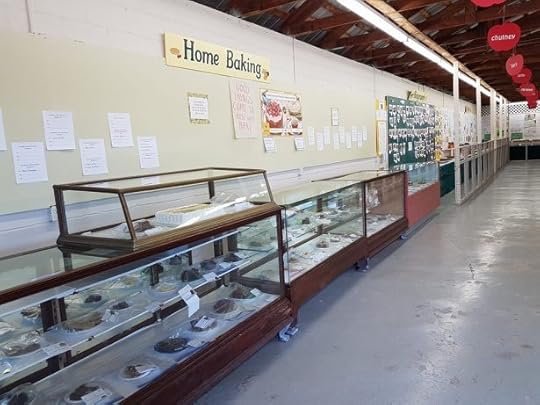
As I walked closer to the building, there were two tables set up, right outside of the entrance. One person was raffling off a quilt made by Mrs. Bert Frizzell, and the other was selling tickets for the annual draw to win a baby beef. Sure enough, as I approached the main door, I spotted Mother, standing along one of the baking counters, talking to Evelyn Bothwell, and Margaret Campbell. Mrs. Willard Shaw and Mrs. Archie Ferguson were working at the next counter, arranging some of the craft displays. The ladies all nodded and smiled at me, knowing that I was one of Mother’s ‘helpers’, responsible for carrying her baking in to the building each year, the evening before the judging took place. I usually had a lemon meringue pie on my lap, in the car, on the way into Perth, and there were countless trays of muffins, loaves, cakes, pies, cookies, bread, rolls and biscuits to carry, carefully, into the building each year. Along with all of those tasty treats, she would also enter photography, flowers, vegetables and sewing, but it was the home baking competition where her talents shone.
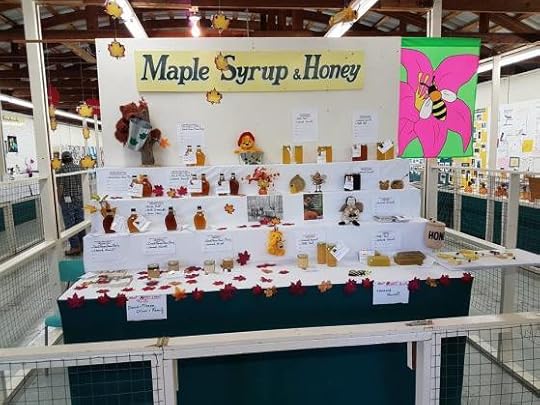
Mother spotted me, smiled excitedly, and waved me over to the counter.
She Won Again!“Your Mother won the most points in the baking category again!” Mrs. Bothwell exclaimed, and the ladies pointed out all of the red ribbons and tags, behind the glass counter. Mother beamed, and said that Mrs. Bell from Balderson had come very close to beating her, and that she’d have to stay sharp for next year!


There were also many other folks who won prizes at the Fair that year as well. There was a gate prize each year, and the ticket number would be drawn, called out, and the winner received ten pounds of Balderson Cheese. Now who wouldn’t want that! They estimated that the crowd that year was around 15,000 and I’m not sure who won the gate prize, but someone went home that night with a big slab of the best cheese in the county.
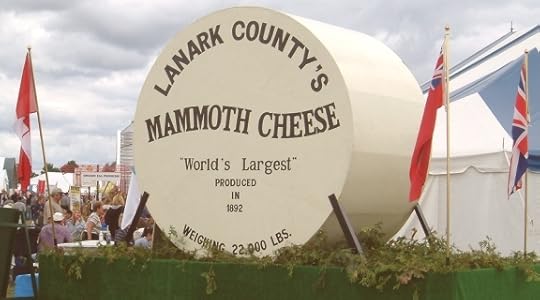
One of the most popular events was the harness racing, and the winner that year was Eddie Norris of Perth. There was also a Tractor Rodeo – contestants had to drive tractors through an obstacle course pulling wagons and manure spreaders. In the 14-18 yrs. division some of our local lads had a good showing. Bill Poole came 1st, Allan Lowry was 2nd, and Brian Miller of Drummond Centre came 3rd. In the 19 yrs. and over division Mervin Conboy, of Maberly, took first place, with Jack James, from Middleville, taking 2nd, and our neighbour from the Third Line, Wayne Conboy, taking 3rd.
Donald Hossie, another neighbour, was the top winner in the seed and grain competition, and Mrs. Robert Moodie, won the Sewing and Fancy work class, with no less than 23 firsts! Mrs. John Auchterlonie, also from the Third Line, took top honours for her vegetables and fruits, and Mrs. Isobel Kent, came first in the Flower competition.
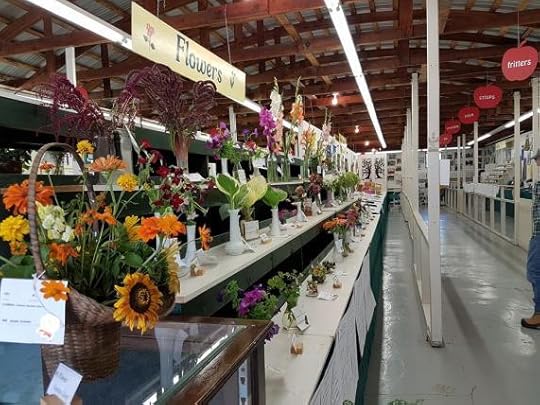
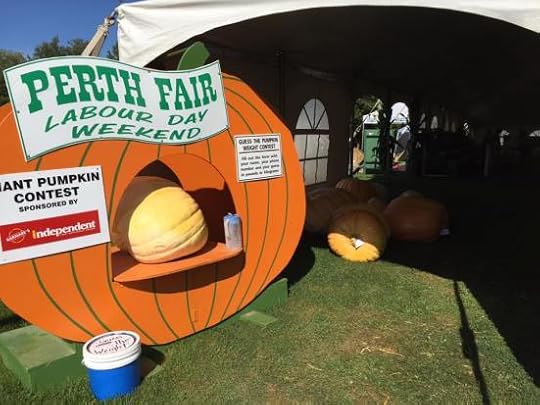
Ray Poole was the winner of the best bale of first cut hay, and our neighbour, John Miller of Glen Tay, won for the best dairy cattle. John’s sister Ruth Miller, won for the best senior calf. Other winners from the Third Line included Paul, Dale, and Jane Brady, winners for their 4H dairy cattle entries. In some of the other 4H competitions local lads Alfred Bowes and Brian Miller, John Miller, and Linda Bell of Balderson were winners.

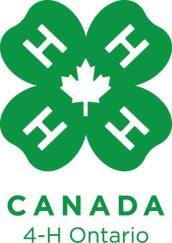
Everyone enjoyed the light and heavy Horse Shows and the livestock competitions. That was the first year that Charolais cattle were introduced into the mix, and so it was quite special to see them in the arena.

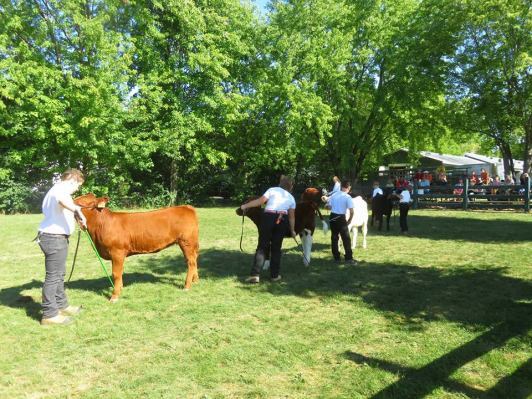
* * *
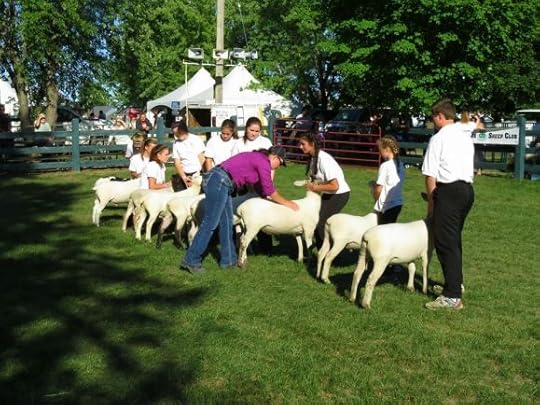
My good friends came to the fairgrounds that Saturday afternoon, and we had a wonderful time, riding the Scrambler, and the Tilt-a-Whirl, screaming, laughing, and then feeling dizzy on our walk back down the ramp, at the end of the ride. We were all a little nervous about riding The Bullet, because while one of the two cars was right side-up, the opposite car was up-side-down. We stood there quite a while watching other people riding, and screaming, and laughing, before we got up enough nerve to try it out ourselves. I didn’t really like being upside-down, and some of my change fell out of my pocket, onto the ground below. Luckily, one of our neighbours, Linda Brady, from the farm up the road, saw it fall, and she stood there and waited, until the ride was finished, and hung onto my change for me.
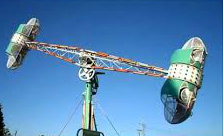
As always, the Grandstand shows at the Perth Fair were great entertainment for people of all ages! Beautiful late summer evenings, clear skies, all the rides lit up, the scents of delicious food in the air, and wonderful live music, made those nights magical!
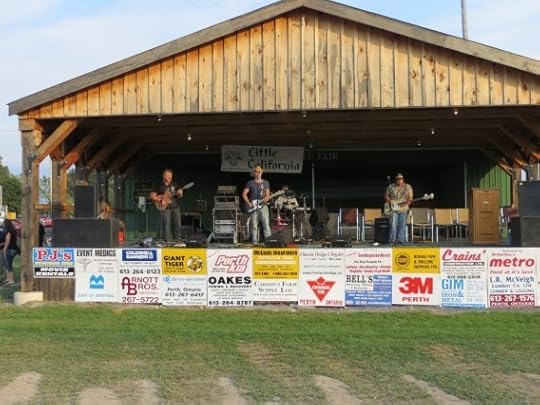
* * *
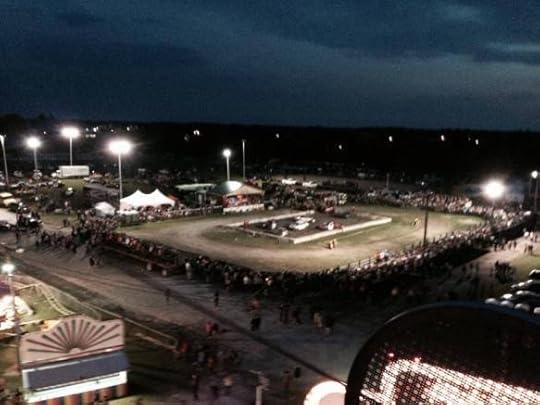
* * *
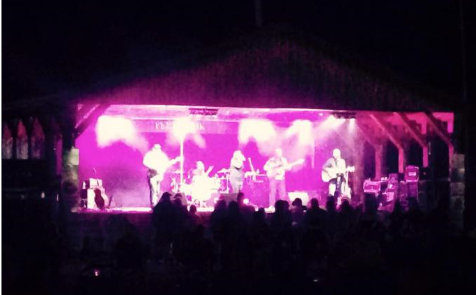
Everyone always came out to see the famous Trans Canada Hell Drivers!
Hell Drivers
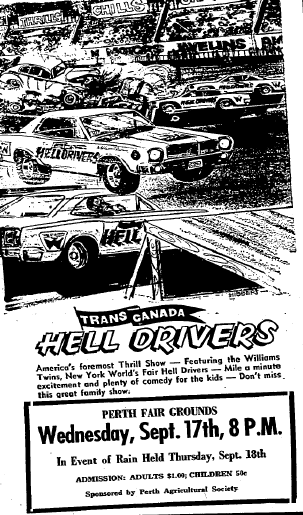
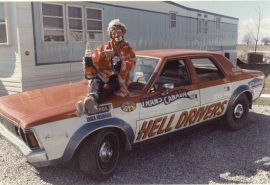
* * *
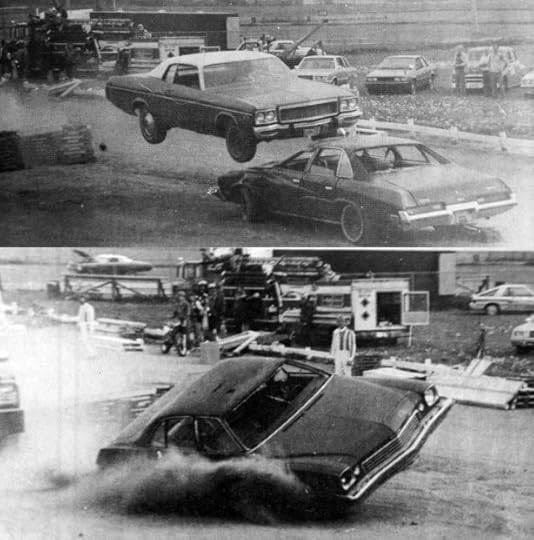
Along with the Grandstand entertainment, one of the highlights of the Fair that year, was the Old Time Fiddlers competition on Sunday, and the musically-gifted Dawson Girdwood walked away with the top prize. Barb Closs from Lanark came second in the step-dancing competition, although we thought she should have come first, she was such a talented performer. Watching the fiddling and step-dancing was a memorable finish to our Labour Day weekend.

The last night of the Fair, as always, was bittersweet. We knew that it was almost over for another year. I walked through the midway one more time, all the way to the Lion’s Hall. The ladies in the Lioness Booth were packing up their big jars of mustard and relish, and some of the nearby vendors were starting to clean their food carts, and take them apart.
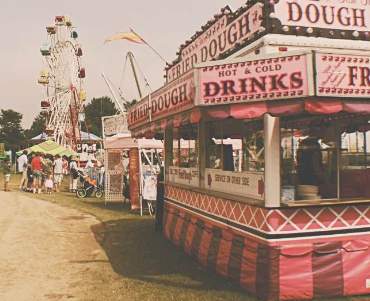
Some diehard fans of the Fair were still playing games; taking a last spin at the Crown and Anchor wheel, or throwing one last pitch at Skeet ball, not wanting the fun to end. Although it was getting late, there were still a handful of people on the rides laughing and screaming. The good-natured folks running the rides didn’t seem to mind and they gave these last few stragglers extra long rides.
As I walked back up through the midway, I took one last look behind me, as if I wanted to freeze the moment in my memory, as I reluctantly climbed into the car. Dad started up the engine, and drove through the side entrance, onto Cockburn Street.
MemoriesIt was a wonderful fair! I sat in the back seat of the car, tired from the busy weekend, as Mother chatted excitedly to Dad, already planning her exhibits for next year’s fair.
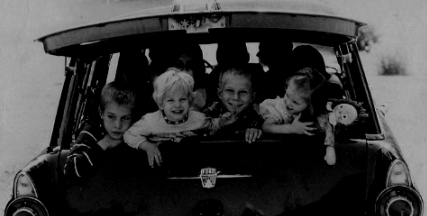
School would be starting soon, and the days would grow cooler, and the sun wouldn’t feel quite as warm or strong as it did for the Fair. In the weeks to come we’d bring our jackets down from the attic, and spend our evenings doing homework, instead of riding our bikes up and down the Third Line. As the daylight hours dwindled down we’d begin to see the onset of nature’s paintbrush, and its random strokes of yellow and orange, dotted across the maple trees in our yard. This would be our last taste of summer for a long while, and what could possibly be a more fitting way to finish off the season, than a glorious sunny weekend spent at the Perth Fair!
…………
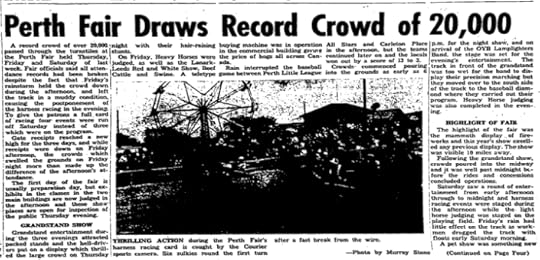
…………
This story is an excerpt from:
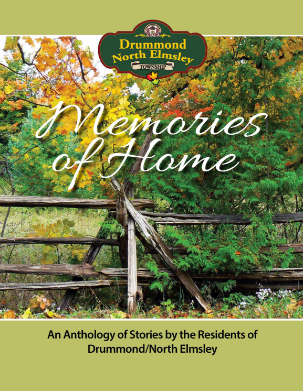
 some photos from: ‘Perth Remembered’, and from ‘Perth Fair’
some photos from: ‘Perth Remembered’, and from ‘Perth Fair’
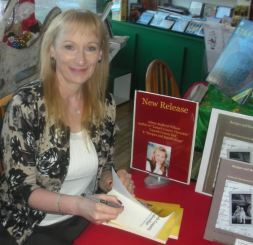
Arlene Stafford-Wilson
Honorary Life Member, Lanark County Genealogical SocietyMember, Association of Professional GenealogistsLanark County Pioneer Families Humanitarian AwardFrancois Bregha Storyteller AwardHeritage Perth Architectural Conservation AwardAuthor of : “Lanark County Christmas”, “Lanark County Comfort”, “Lanark County Collection”, “Lanark County Calling”, “Lanark County Classics”, “Lanark County Connections”, “Lanark County Calendar”, “Lanark County Chronicle”, “Lanark County Kid”, & “Recipes & Recollections”, “Lanark County Kitchen: A Maple Legacy from Tree to Table”, “Lanark County Classrooms: Remembering Our School Days”.New ReleaseFall 2025“Lanark County Mansions: Spectacular Homes and Fascinating Families”
“Step inside a world of incredible wealth where prominent families enjoy the finer things, residing in some of the most magnificent residences in Lanark County. Meet the people who lived in these palatial estates and discover their triumphs, their tragedies, and even some shocking scandals. Learn the closely guarded secrets of these business barons, politicians, and distinguished members of the social elite, as they lived their lives in a Lanark County mansion.”
Book Launch: Saturday, September 20, 2025, 12 noon – 3 p.m.
at The Book Nook, 60 Gore Street E., Perth, Ontario
Call 613-267-2350 to reserve/pre-order a signed copy. Books are $25.99
http://www.staffordwilson.comAugust 25, 2025
Ghosts of Mutton’s Hollow

Glen Tay-Harper Road
There were plenty of stories, mostly from the old-timers – frightening tales of the ghosts of Mutton Hollow. Once, not far from the main road that ran between Glen Tay and Harper the well-traveled thoroughfare of long ago has been replaced by a newer road. Originally it wound along a rocky hill, and into a low-lying swamp and that’s where most of the paranormal sightings took place.
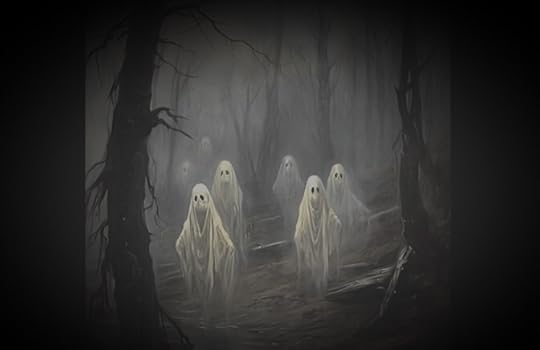
Long ago, before my time, there was a quarry there, an abandoned man-made excavation that would become the grave for the cattle killed in the Glen Tay Train Wreck of 1942. A freight train crashed into a passenger train at Glen Tay Station, derailing 8 cars, injuring 12 people, and killing 18 head of cattle.
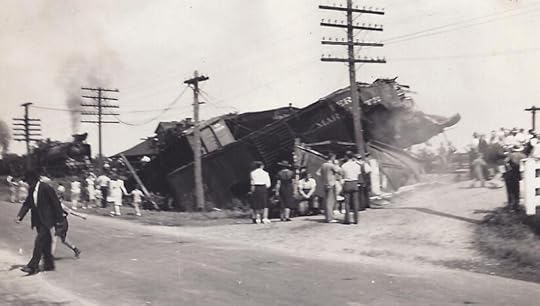
Glen Tay Train Wreck 1942
Still, the animal burying ground, didn’t explain the sightings of dark ominous human-like figures along the roadway, or the black dog that appeared for many decades along the road at night, disappearing from sight as quickly as it was spotted.
Some of the old timers said there was a connection to that particular area and an old hemlock tree which grew beside a large boulder. There were claims that if a person could make it as far as the boulder then they were no longer haunted by the spirits, almost as if it was the border of a ‘haunting zone’. The hemlock tree is no longer there, but the boulder still remains in the same spot.
A Long History
of Sightings
There were sightings that dated to the earliest settlers who traveled along that road with their horse and buggies. There were many accounts of a frightening dark figure who rose from the lowlands and walked alongside the buggy as far as the boulder, then vanished. The same was said for the sightings of the black dog. Some said it was a black wolf that came up from the ditch and traveled underneath a traveler’s buggy as it clip-clopped down the road. People who had experienced this reported feelings of fear, tension and anxiety that subsided as quickly as they came.
After the days of the horse and buggy, a new generation of old-timers had their stories to tell. There were sightings of the ominous dark figure stepping up from the ditch onto the road right in front of their cars. Most would slam on their brakes, proceed toward the figure and then see nothing. The same held true for the black dog who appeared on the road, the cars would brake, and when they reached that point on the road where the dog was first spotted – it was gone. A few brave souls even parked their cars and searched the ditches for the dark human figure or the black dog, but none were ever found.
On August 1st, 1984, Don Crawford, columnist for, “The Perth Courier”, wrote an account of his own experiences with the ghosts of Mutton Hollow. There is a transcription of his article below, and the actual news-clipping as it appeared in the newspaper.

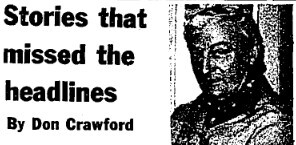
Transcribed:
“I drove through Mutton’s Hollow the other night. Actually, you have to go out of your way if you want to go through Mutton’s Hollow since it has been by-passed by the new paved road from Glen Tay to Harper. Historic and famous places are always getting by-passed it seems.
The reason the original road ran through the hollow was because of a rocky hill on the east which fell off into a small bog. That’s where the ghosts were. On the south side of the hill there was some kind of a quarry which was abandoned before my time and later became the burying ground for scores of cattle killed in “The Great Glen Tay Train Wreck”. On top of the second hill was “Lovers Lane, renowned for its privacy and atmosphere. Farther in the lane was a bee colony with wooden hives placed about. And a little to the north was the small gravel pit for fixing the township roads. I suppose the entire Mutton’s Hollow area might take in ten or twelve acres.
“…the burying ground
for scores of cattle killed
in the Glen Tay train wreck…”

Fascinating and scary were the stories told by the older folks visiting relatives on a winter’s evening, of the wraith-like creatures which dwelled in the bog at Mutton’s Hollow. True, none of the tellers had ever actually seen first hand any spectres or phantoms, but they had known those who had and would take their oath upon it.

A favourite ghost story was about the apparition that stalked the hollow on the darkest nights. He (it) was an enormous fellow who rose up by the roadside without warning and would walk along beside the buggy until you had passed a certain point, then would disappear as quickly as it had come. Each time the story was related the teller mentioned the point at which the ghost disappeared, a large boulder near a hemlock tree.
…a black dog-like figure
that approached you…”
Another story featured a black dog-like figure that approached you head-on. It would disappear under the horse and buggy or wagon and never come out the other end, leaving you with the uncomfortable feeling of having it travel along with you. Then at a certain place the feeling would be gone and you would proceed with the hair on the back of your neck settling down again.

Unlike other ghosts that wail and moan and shriek, the ones in Mutton’s Hollow went about their nocturnal work in silence, which may or may not have been a blessing, depending, I suppose, upon which way you’d rather be scared out of your wits.
I passed through the hollow alone once when I was eleven. I’d been sent in the afternoon to the store at Glen Tay to get some sugar for cucumber pickling with the orders to get back as soon as possible. But the trains coming and going at the station, and the man with the black half-sleeves to his elbows and the eyeshade tapping out messages on the telegraph key, held my fascination until it was quite dark.
…tapping out messages
on the telegraph key…”

I slowed my pace as I approached the hollow, realizing only now my folly in not starting home sooner. With trepidation I proceeded, peering into the darkness. A stone rolled under my step, checking me up. I didn’t dare stop. I tried whistling but no sound came. Dark shapes came and went by the roadside. I was in the bottom of the hollow now. A twig snapped off to my right. Two green eyes shone from the tall grass and were gone in an instant. I picked up speed, like those fast-walk runners do at the indoor track meets, but I didn’t seem to be going any faster. Something seemed to be keeping pace with me in the ditch. Terror prevented me from turning my head; if I looked back, what horror would confront me when I looked forward again? I tried humming, “Cowboy Jack”, but the words escaped me and all that came out was a plaintive quavering whisper. The boulder was just up ahead, and the hemlock tree.
Could I make it? Would I ever get there? If I could just reach the end of the haunted area I’d never do anything bad again. I’d say my prayers. I wouldn’t fight with my brothers. I’d do what I was told the very first time! Please, please just let me get out of here!
I was at a full run now as I passed the boulder and the hemlock tree, and I kept that gait the full two miles until I reached home.
As I drove through there the other night I chuckled at the silly superstitions of years gone by. You’d hardly know the place. The quarry isn’t recognizable now, a township hall and a garage near the site. Gone is the lovers lane area, profaned by the township dump, acrid blue smoke befouling the place where the bee hives had stood.
The hemlock tree is gone, but the boulder remains. As I passed it, something seemed to loom up, just for a second, then fade away. Just the headlights reflecting something, no doubt. But I couldn’t explain the strange shiver that crept up my back.
Don Crawford’s Article
Aug. 1, 1984
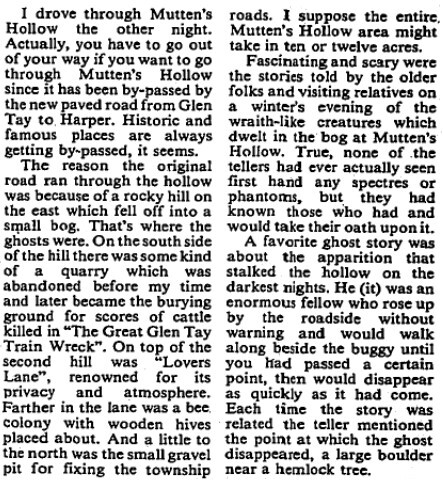
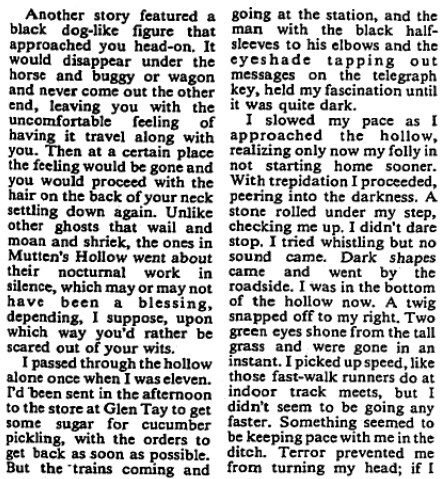
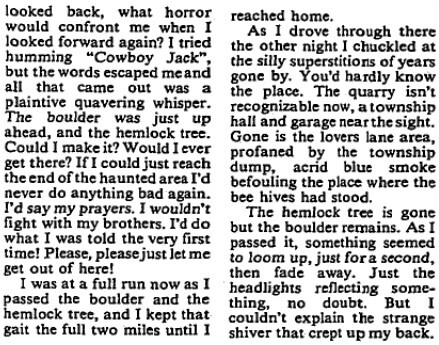
Don Crawford’s article appeared in, “The Perth Courier”, on August 1st, 1984
New Road
Although at one time there were many accounts of the ghosts of Mutton Hollow, there were far fewer encounters once that section of road was re-routed. It would be interesting to hear of more recent sightings, and to learn about the link to the hemlock tree and the boulder which seemed to mark a boundary for the ghosts of Mutton Hollow.
The stories of the Ghosts of Mutton Hollow remain one of the fascinating glimpses into the history of Tay Valley Township, the former historic Bathurst Township, Lanark County.

Arlene Stafford-Wilson
Honourary Life Member Lanark County Genealogical Society
Lanark County Pioneer Families Humanitarian Award
Francois Bregha Storyteller Award
Heritage Perth Architectural Conservation Award
Member – Association of Professional Genealogists
New Release:

“Step inside a world of incredible wealth where prominent families enjoy the finer things, residing in some of the most magnificent residences in Lanark County. Meet the people who lived in these palatial estates and discover their triumphs, their tragedies, and even some shocking scandals. Learn the closely guarded secrets of these business barons, politicians, and distinguished members of the social elite, as they lived their lives in a Lanark County mansion.”
Call 613-267-2350 to reserve a signed copy.
August 21, 2025
Lanark County Mansions: Book Launch
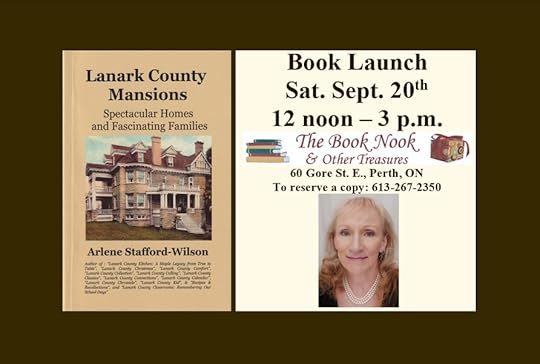
Lanark County Mansions:
Spectacular Homes and Fascinating Families
“Step inside a world of incredible wealth where prominent families enjoy the finer things, residing in some of the most magnificent residences in Lanark County. Meet the people who lived in these palatial estates and discover their triumphs, their tragedies, and even some shocking scandals. Learn the closely guarded secrets of these business barons, politicians, and distinguished members of the social elite, as they lived their lives in a Lanark County mansion.”
* * *
To reserve/pre-order a signed copy, or for more information: Call The Book Nook at 613-267-2350.

Arlene Stafford-Wilson
Honorary Life Member, Lanark County Genealogical Society
Lanark County Pioneer Families Humanitarian Award
Francois Bregha Storyteller Award
Heritage Perth Architectural Conservation Award
Member, Association of Professional Genealogists
Heritage Perth Architectural Conservation Award
Author of : “Lanark County Kitchen: A Maple Legacy from Tree to Table”, “Lanark County Christmas”, “Lanark County Comfort”, “Lanark County Collection”, “Lanark County Calling”, “Lanark County Classics”, “Lanark County Connections”, “Lanark County Calendar”, “Lanark County Chronicle”, “Lanark County Kid”, & “Recipes & Recollections”, and “Lanark County Classrooms: Remembering Our School Days”
August 14, 2025
Ferguson’s Falls & The Stumble Inn
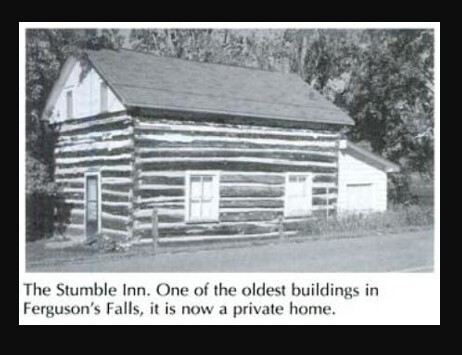 Photo: “A History of Drummond Township”, by John Ebbs, 1999, p. 21.
Photo: “A History of Drummond Township”, by John Ebbs, 1999, p. 21.Stumble Inn of Ferguson Falls
“It was a little shack very close to the old Mississippi, just across the bridge, coming down from the church; probably not room for more than twelve Irishmen at a time, if they could get along, and if that didn’t work, some would be out in yard ,or in the river.”
Thomas Joseph Stafford (1921-2018)
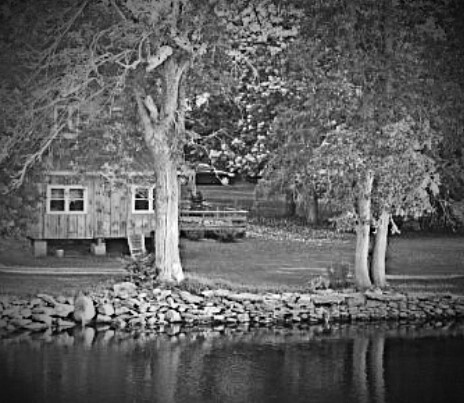 A view of the Stumble Inn from the Mississippi River
A view of the Stumble Inn from the Mississippi River“The Stumble Inn was operated by Billy McCaffrey. He was a very, very, short man, with a curved back. His tavern was located right beside the river, when you crossed the old bridge, across the Mississippi River, coming down from the Catholic church. I remember it around 1927 to early 1930s. The horses were stabled across the road in an open shed at Charles Hollinger’s, the auctioneer. We walked across the bridge up to church for mass. After mass the Catholic brethren would stop in at the Stumble Inn. You could get a shot of something for the trip home. There was also a lot of Poker played there, which was frowned on in the community. There were also lots of ghost stories told there.”
quote from 2012 by Thomas Stafford (1921-2018)
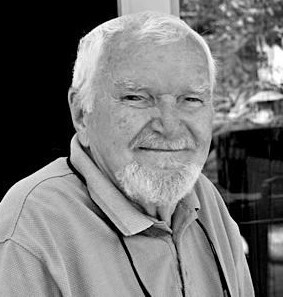 Thomas Stafford, (1921-2018), son of Thomas Patrick Stafford and Margaret Doyle Stafford
Thomas Stafford, (1921-2018), son of Thomas Patrick Stafford and Margaret Doyle Stafford“There would be music at the Stumble Inn. There was always music where the Irish gathered. I remember Jimmy (Richards) playing the fiddle. I spent quite a few days at Richards’ visiting with your dad ,Tib (Tobias Stafford). Clara (Richards Carberry) would feed us cookies. Jimmy thought we were a pain in the ass, I think. Peter (Stafford) was a great fisherman of mud pouts from the old Mississippi. In Ferguson Falls they were all related, either before or after they arrived in Canada from Wexford.”
(quote from Thomas ‘Tom’ Stafford 1921-2018)
(James ‘Jimmy’ Richards was Dad’s uncle on his Mother’s side. Clara Richards, Dad’s aunt, was Jimmy’s sister. Clara Richards married Thomas ‘Tom’ Carberry, a descendant of one of the ‘Seven Irish Bachelors’ of Ferguson Falls. The Richards homestead was next door to the Stafford homestead on the 11th concession of Drummond Township. Dad’s parents – Anastasia ‘Stacy’ Richards married Michael Vincent ‘Vince’ Stafford – the boy next door) Peter Stafford was Dad’s brother) ‘Wexford’ refers to County Wexford, Ireland. Jimmy Richards played his fiddle at the Stumble Inn on a regular basis. His fiddle was passed down to Dad, then to me.)
Billy McCaffrey, owner of The Stumble Inn
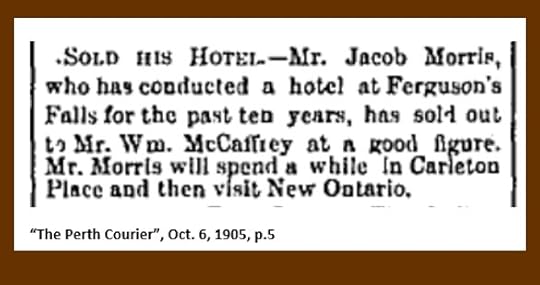
William Henry ‘Billy’ McCaffrey, (1869-1940), was the son of Joseph McCaffrey, and Ellen McGarry McCaffrey. Billy’s ancestor, Thomas McCaffrey was the first settler and resident of the village of Ferguson Falls, arriving in 1815.
Billy’s mother, Ellen McGarry McCaffrey:
 Ellen McGarry McCaffrey 1837-1917
Ellen McGarry McCaffrey 1837-1917Ellen McGarry McCaffrey and her husband, Joseph McCaffrey had ten children:
Mary McCaffrey 1861-1944 – was a tailorJulia Ann McCaffrey 1863-1944Thomas McCaffrey 1866-1913. Thomas married Margaret Doyle and they lived on the McCaffrey homestead on the 8th concession of Drummond Township. Thomas died age 46 of tuberculosisPeter McCaffrey 1867-1895 – died age 28 of dropsyWm. Billy McCaffrey 1868-1940 – saddler by trade, owned a hotel in Ferguson Falls, and later, owned the Stumble InnMargaret McCaffrey 1874-1917 died age 43 of pernicious anemiaLoretta McCaffrey 1872-1941 was a dressmakerGertrude McCaffrey 1875-1918 died age 38 of pernicious anemiaJosephine McCaffrey 1877-1931 trained as a nurse and worked in New York, died age 52 of cerebral hemorrhageTeresa McCaffrey 1879-1935, married Martin Sylvester Grace. Their children: Harold Francis Grace, Ursula Grace Kehoe Bent, Helen Grace Butterworth, Kathryn Grace Daley, and Reverend Sister Anna Gertrude.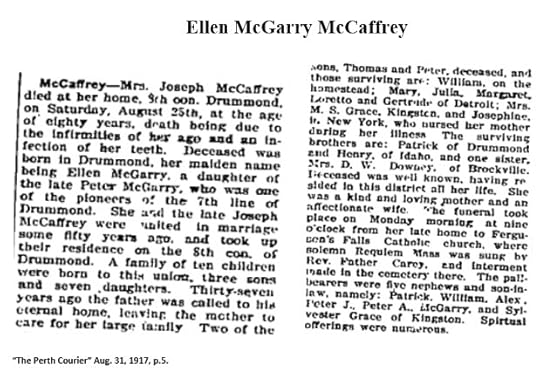 Ellen McGarry McCaffrey, daughter of Peter McGarry, niece of pioneers Elizabeth McGarry Stafford and Tobias Stafford
Ellen McGarry McCaffrey, daughter of Peter McGarry, niece of pioneers Elizabeth McGarry Stafford and Tobias StaffordAfter operating his successful and much-loved community gathering spot, the Stumble Inn, Billy passed away in 1940.
“The late Mr. McCaffrey was a man of sterling qualities, and possessed the good-will and esteem of all who knew him.”
 Billy McCaffrey’s obituary from “The Perth Courier” Aug. 2, 1940, p.3
Billy McCaffrey’s obituary from “The Perth Courier” Aug. 2, 1940, p.3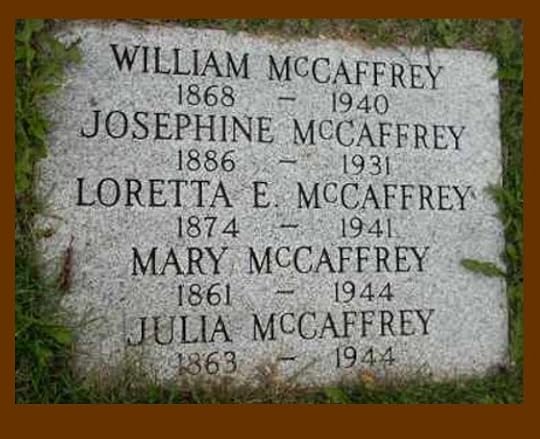 Billy’s and some of his siblings, St. Patrick’s cemetery, Ferguson Falls
Billy’s and some of his siblings, St. Patrick’s cemetery, Ferguson FallsFerguson Falls
(sometimes written as Ferguson’s Falls, or Fergusons Falls, depending on the era)
Originally known as Milford, Fergusons Falls was renamed in honor of the early settler Captain Ferguson when a post office was established there. This was the closest village to the Stafford farm and was a source for supplies, postal services, blacksmith services, social activities, and later St. Patrick’s Church.
Thomas McCaffrey was the first settler coming in 1815. McCaffrey was a close friend of Tobias Stafford and Betsy (McGarry) Stafford. Thomas was one of the witnesses to their marriage ceremony in St. John’s Church in Perth. He also signed his name as witness to one of Tobias’ later land transactions, and was present at the baptisms of some of the Stafford children.
Other early Ferguson Falls residents were John and Patrick Quinn, Patrick and Martin Doyle, James Carberry, James Power and William Scanlon. Two Stafford girls married into the Quinn family. The Hollinger family was also among the first settlers. By 1857, Ferguson Falls was booming. John Doyle was the Innkeeper, James McCaffrey was listed in the business directory as a Wagon Maker, and John & Michael McCaffrey were the local Blacksmiths. John Stafford, Tobias Stafford and Elizabeth McGarry’s son, was the area Shoemaker, and would later open a shoe store in Almonte, then in Perth. There was also a saw-mill, and a grist mill owned by Robert Blair and a hotel owned by Charles Hollinger.
Some history of Ferguson Falls:
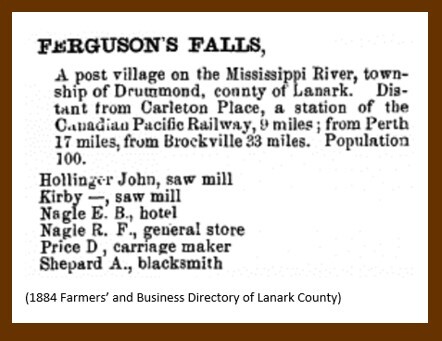 1884 Farmers’ and Business Directory
1884 Farmers’ and Business Directory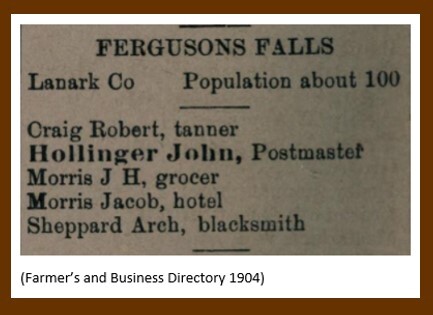 1904 Business Directory for Lanark County
1904 Business Directory for Lanark County 1916 Farmers’ and Business Directory for Lanark County
1916 Farmers’ and Business Directory for Lanark CountyA note on the local school:
“In 1894 Miss Mary Stafford taught, and then in 1901-1909 Miss Maggie Doyle of Drummond Twp (who later married Thomas Patrick Stafford).
In 1901 the teacher’s salary was $240.00 dollars a year. In 1905 it was $250.00. 1943-1946 Miss Mary Phelan of Lanark was the teacher. Her salary was $1000.00 a year and she had 9 pupils.”
(quote from Gail McFarlane, taken from the Tweedsmuir history of Ferguson Falls)
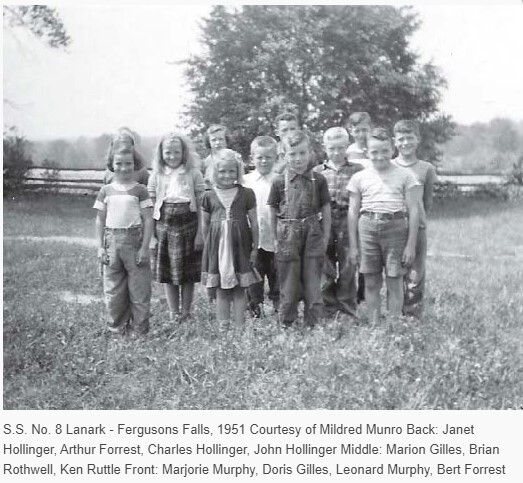
 S.S. # 15 Drummond Township School, class of 1928-29, with our cousins, Thomas ‘Tom’ Stafford (1921-2018) , Patricia ‘Pat’ Stafford, and Nora Stafford, (children of Thomas Patrick Stafford and Margaret ‘Maggie’ Doyle Stafford) Original photo at the Lanark Museum.
S.S. # 15 Drummond Township School, class of 1928-29, with our cousins, Thomas ‘Tom’ Stafford (1921-2018) , Patricia ‘Pat’ Stafford, and Nora Stafford, (children of Thomas Patrick Stafford and Margaret ‘Maggie’ Doyle Stafford) Original photo at the Lanark Museum.S.S. # 15 Drummond
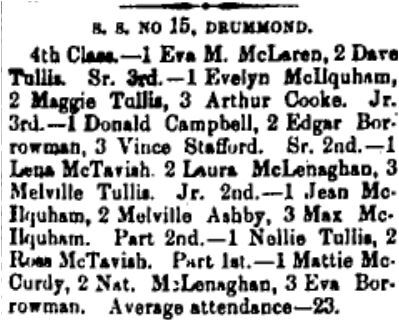
Surnames: MCLAREN, TULLIS, MCILQUHAM, COOKE, CAMPBELL, BORROWMAN, STAFFORD, MCTAVISH, MCLENAGHAN, ASHBY, MCCURDY
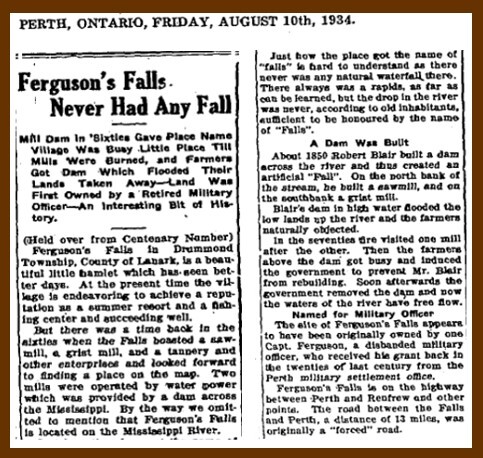 “The Perth Courier”, August 10, 1934 part 1 of 3
“The Perth Courier”, August 10, 1934 part 1 of 3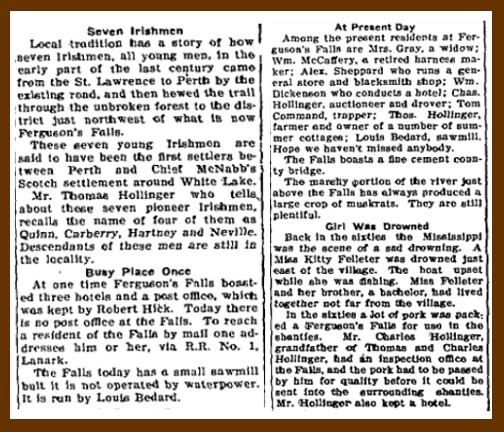 “The Perth Courier”, August 10, 1934 part 2 of 3
“The Perth Courier”, August 10, 1934 part 2 of 3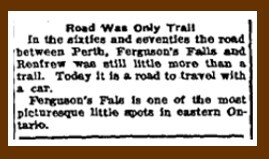 “The Perth Courier”, August 10, 1934 part 3 of 3
“The Perth Courier”, August 10, 1934 part 3 of 3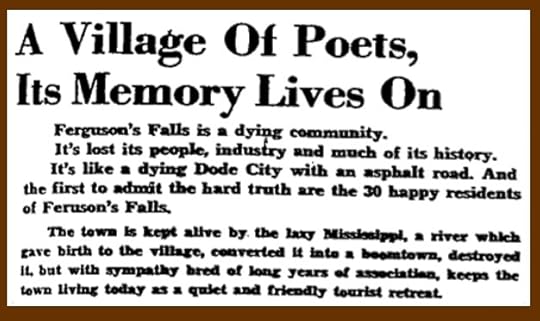 “The Perth Courier” Sept. 13, 1962, p.3
“The Perth Courier” Sept. 13, 1962, p.3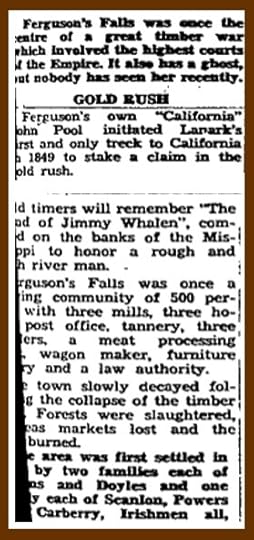 “The Perth Courier” Sept. 13, 1962, p.3
“The Perth Courier” Sept. 13, 1962, p.3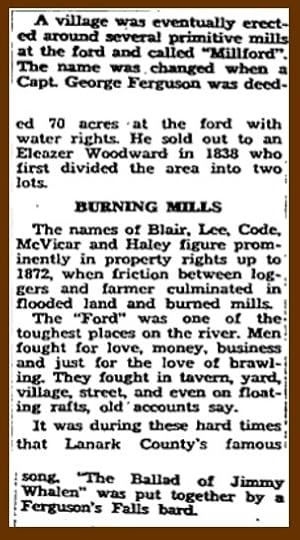 “The Perth Courier” Sept. 13, 1962
“The Perth Courier” Sept. 13, 1962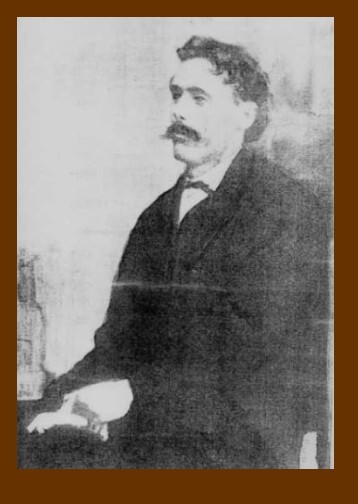 James ‘Jimmy’ Phelan (pronounced Whelan) Local lore says his lost love wanders in Ferguson Falls, along the Mississippi River at night, searching for Jimmy. The Phelan farm backed directly onto the Stafford homestead on the 11th concession of Drummond Township. Tim Doyle of Lanark village is said to have written the song.
James ‘Jimmy’ Phelan (pronounced Whelan) Local lore says his lost love wanders in Ferguson Falls, along the Mississippi River at night, searching for Jimmy. The Phelan farm backed directly onto the Stafford homestead on the 11th concession of Drummond Township. Tim Doyle of Lanark village is said to have written the song.Ballad of Jimmy Whelan
All alone as I strayed by the banks of the river
Watching the moonbeams as evening drew nigh
All alone as I rambled, I spied a fair damsel
Weeping and wailing with many a sigh.
Weeping for one who is now lying lowly
Mourning for one who no mortal can save
As the foaming dark water flow gently about him
Onward they speed over young Jimmy’s grave.
She cries, “Oh, my darling, please come to me quickly
And give me fond kisses that oft-times you gave
You promised to meet me this evening, my darling
So now, lovely Jimmy, arise from your grave.”
Slowly he rose from the dark, stormy waters
A vision of beauty more fair than the sun
Saying “I have returned from the regions of glory
To be in your dear loving arms once again.”
“Oh, Jimmy, why can’t you tarry here with me
Not leave me alone, so distracted in pain.”
“Since death is the dagger that’s cut us asunder
Wide is the gulf, love, between you and I.”
“One fond embrace, love, and then I must leave you
One loving farewell, and then we must part.”
Cold were the arms that encircled about her
Cold was the body she pressed to her heart.
Slowly he rose from the banks of the river
Up to the heavens he then seemed to go
Leaving this fair maiden, weeping and mourning
Alone on the banks of the river below.
(local Irish legends told of the ‘gates of glass’, where one could pass between this world and the next, through the water of a lake or river, at dusk)
 “The Perth Courier” continued from article above
“The Perth Courier” continued from article above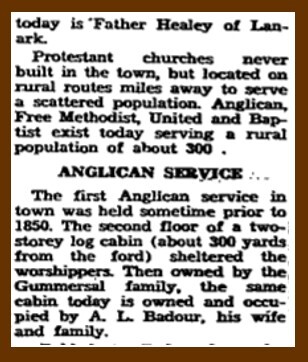 “Perth Courier” article – continued
“Perth Courier” article – continued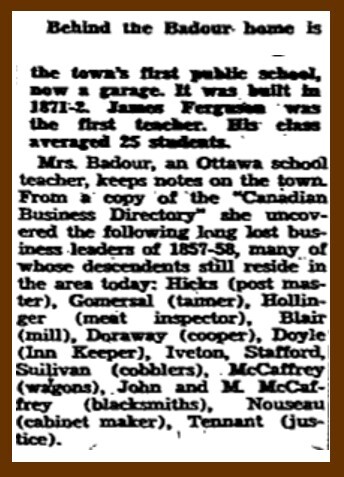 “Perth Courier” article continued
“Perth Courier” article continued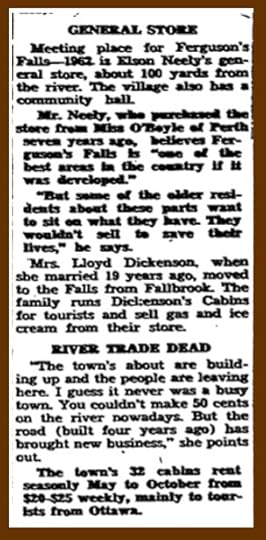 “The Perth Courier” – article continued
“The Perth Courier” – article continued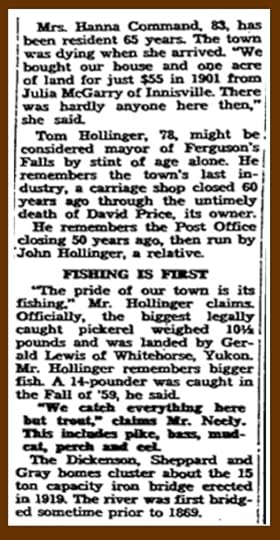 “The Perth Courier” – article continued
“The Perth Courier” – article continued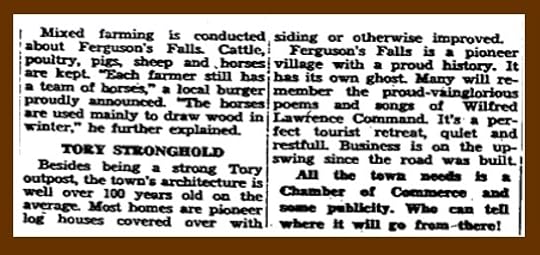 “The Perth Courier”, Sept. 13, 1962, p3, end of article
“The Perth Courier”, Sept. 13, 1962, p3, end of articleA Return to Our Roots in 2012
Archives Lanark celebrated their 10th Anniversary in October of 2012, at the Ferguson’s Falls Community Hall. There were local dignitaries from Drummond Township, and Doug Bell made a presentation of a 200 year old artifact, – an original settler’s trunk from pioneer Sutton Frizzell, and his land documents that were found in the trunk.
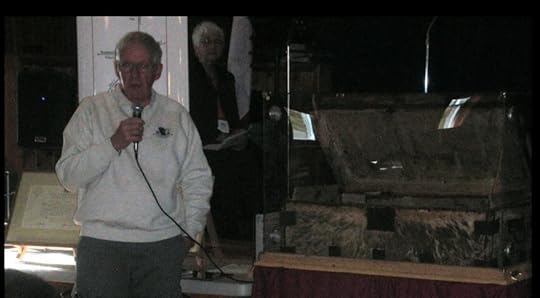 Sutton Frizell’s trunks presented by Doug Bell to Archives Lanark
Sutton Frizell’s trunks presented by Doug Bell to Archives Lanark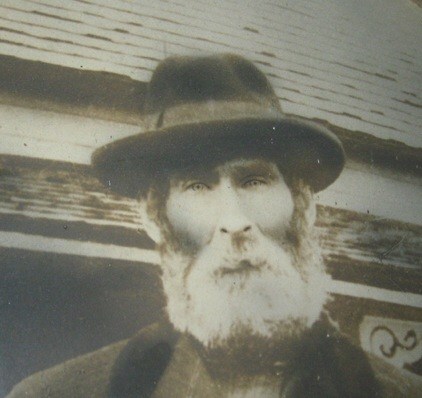 Sutton Frizell, one of the first elected Councillors in Drummond Township in 1850, along with Thomas McCaffrey, Murdock McDonald, Patrick Dowdall, and John Thompson
Sutton Frizell, one of the first elected Councillors in Drummond Township in 1850, along with Thomas McCaffrey, Murdock McDonald, Patrick Dowdall, and John ThompsonThere were also displays showing some highlights of the work that the Archives has done, and the variety of resources available for local researchers.
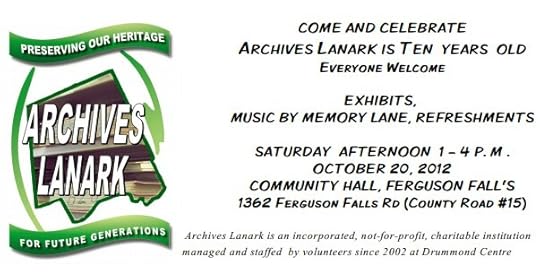
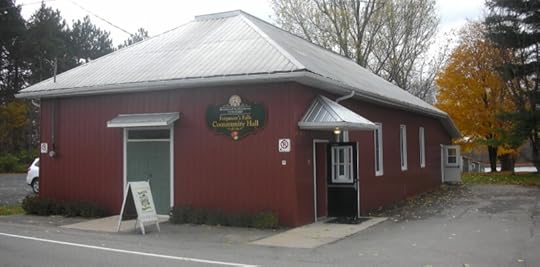 Ferguson Falls Community Hall, Oct. 12, 2012
Ferguson Falls Community Hall, Oct. 12, 2012 Archives Lanark 10th anniversary 2012 – entertainment by ‘Memory Lane’, Mark Labelle on guitar on far left, Leo Scissions on guitar, with Heather Johnston on fiddle, and Jack Greer on banjo. (thanks to Stacey Horne, Arlene Quinn, and others who provided the names of the band members)
Archives Lanark 10th anniversary 2012 – entertainment by ‘Memory Lane’, Mark Labelle on guitar on far left, Leo Scissions on guitar, with Heather Johnston on fiddle, and Jack Greer on banjo. (thanks to Stacey Horne, Arlene Quinn, and others who provided the names of the band members)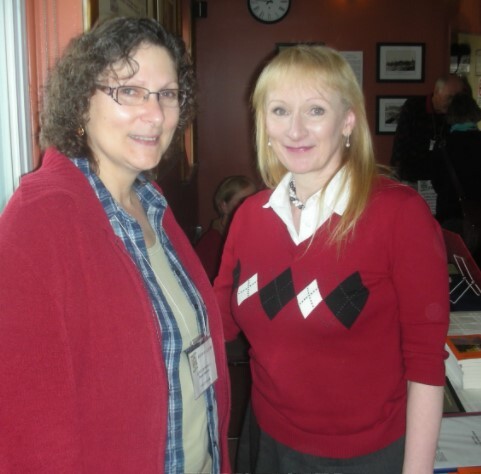 Archives Lanark 10th Anniversary in 2012, with Lanark County Genealogical Society (past) President Janet Dowdall (left) , and LCGS member, Arlene Stafford-Wilson
Archives Lanark 10th Anniversary in 2012, with Lanark County Genealogical Society (past) President Janet Dowdall (left) , and LCGS member, Arlene Stafford-Wilson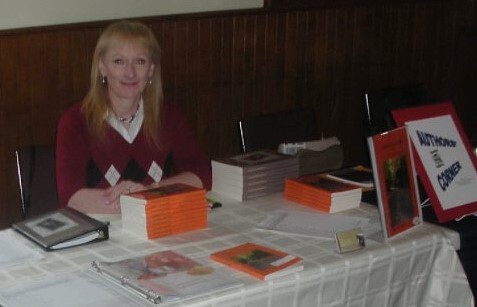 Arlene Stafford-Wilson at the Authors Corner, Ferguson Falls Community Hall, October 2012
Arlene Stafford-Wilson at the Authors Corner, Ferguson Falls Community Hall, October 2012Autumn in Ferguson Falls
 quote from “Lanark County Connections: Memories Among the Maples”
quote from “Lanark County Connections: Memories Among the Maples”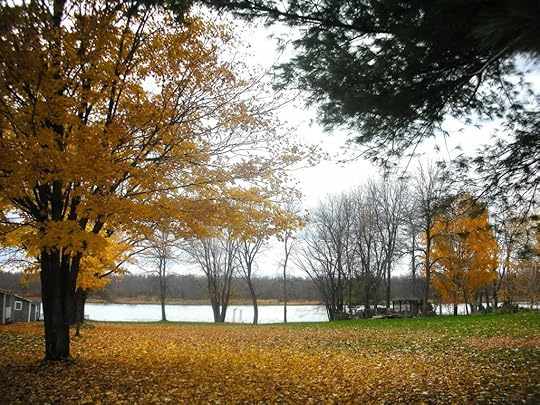 Picturesque Ferguson Falls, along the Mississippi River
Picturesque Ferguson Falls, along the Mississippi RiverStafford family Sunday drives in the 1960s and 1970s began on the Third Line of Bathurst, often involved detours though Balderson and Lanark village, but they always seemed to end up at Ferguson Falls. Our father was born and raised on the 11th concession of Drummond Township, on the ancestral Stafford farm, settled by pioneer, Tobias Stafford in 1816. Our ancestor spent his first year on what became known as Stafford Island on the Mississippi River before building a home.
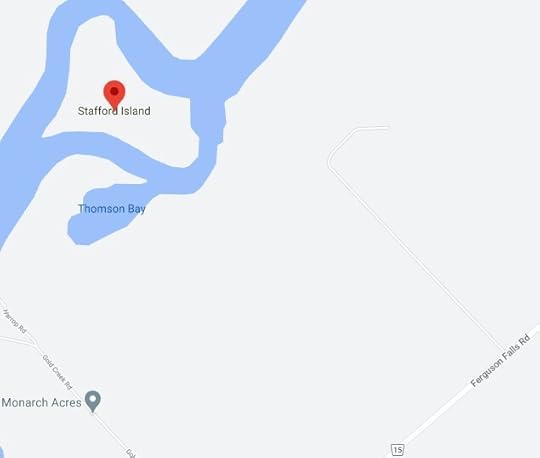
In the earliest days of the settlement, priests would travel to these small communities, and Sunday mass was held in someone’s home. Once St. John’s Church in Perth was built, the pioneers travelled by horse and buggy, or horse and cutter, to attend services, until 1856, when St. Patrick’s Church was established, along the river.
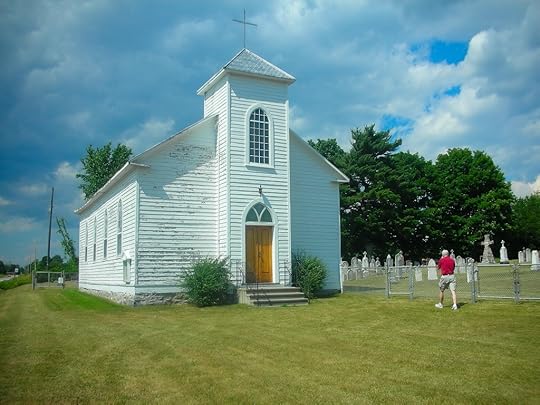 St. Patrick’s Roman Catholic Church, and my brother, Roger Stafford, in Ferguson Falls
St. Patrick’s Roman Catholic Church, and my brother, Roger Stafford, in Ferguson Falls
Sunday Drives…..
…And so, we returned again and again to Ferguson Falls on our Sunday drives; to the pretty village in Drummond Township. We listened to our father’s accounts of the glory days of the Prestonvale ball team, and the long walks to S.S. # 16 Drummond School in snowstorms. We always stopped at St. Patrick’s church, and walked up and down through the rows of the graves of our ancestors. Dad’s parents were buried there, and his grandparents, and the oldest ones, who had come from Ireland. The old families were all connected by marriage – Quinn, McKittrick, Richards, Carberry, Carroll, Ryan, McCaffrey, and the rest; and he pointed to the headstones as we walked through the rows.
There were always stories of the infamous Stumble Inn, across the bridge from the church, and the card-games, and the drinking, and the fighting. We heard about Billy McCaffrey and how he sold whiskey at all hours of the day and night from his modest establishment. We learned of the Hollinger family and the generations of local auctioneers, and their busy hotel that catered to loggers. The loggers danced in their spiked boots and old Charlie Hollinger had to replace the floors once a year. We heard about the McEwen family and visited their popular maple shack in the spring. We heard the local names over and over: Blair, McFarlane, Horricks, Rathwell, Cullen and Kehoe.
We learned that the Irish Roman Catholics were a devoted bunch, loyal to their church, but also possessed an entirely different belief system that included ghosts and fairies, and the little people. We heard about Jimmy Whalen, a neighbour to the Stafford family, and how his lover could still be seen late at night walking along the banks of the Mississippi River, searching for her long lost Jimmy. We listened to stories about the lumber wars in the old days between the McLaren and Caldwell families, and the yearly cattle drives to Carleton Place.
The Sunday drive always ended the same way, with a visit to Lloyd and Evelyn Dickenson’s store for an ice cream cone and a bottle of Pure Spring pop. Dad and Lloyd talked about the old days, and walked together along the shore, near the cottages, recounting tales of catching bullfrogs, and fishing in the river.
I miss our drives to Ferguson Falls, and stopping for a bag of curd at the Balderson Cheese Factory along the way, visiting the graves of our ancestors, walking where they walked, and hearing the stories of the good old days. Dad, and his cousin, Tom, are gone now, but their stories live on. I often wonder if they told the same stories again and again so that we would remember; remember the place where the ancestors settled, remember the customs and legends from the old country, remember so that we could tell their stories, of this special place, called Ferguson Falls.
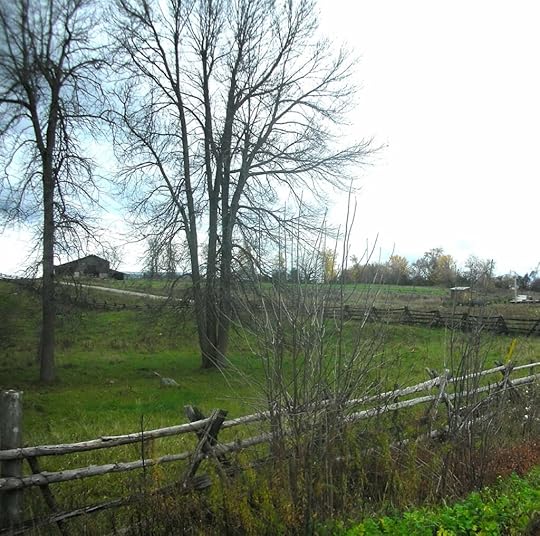
The old families of Ferguson Falls: Badour, Bennett, Blair, Byrne, Byrnes, Carberry, Closs, Craig, Cooke, Cullen, Cunningham, Cuthbertson, Dickenson, Donnelly, Doroway, Doyle, Ebbs, Ferguson, Finlayson, Forrest, Giles, Gommersall, Grey, Haley, Harrington, Hartney, Hicks, Hickey, Hogan, Hollinger, Horricks, Ireton, Keefe, Kehoe, Kenny, Little, McCaffrey, McEwen, McFarlane, McGarry, McIntyre, McIlquham, McLaughlin, McLenaghan, McNaughton, Montgomery, Moran, Moulton, Murphy, Murray, Nagel, Neville, O’Connor, O’Keefe, O’Sullivan, Phelan, Poole, Power, Price, Quinn, Rathwell, Robinson, Rothwell, Richards, Ruttle, Ryan, Scanlon, Spence, Stafford, Sullivan, Traill, Tullis.
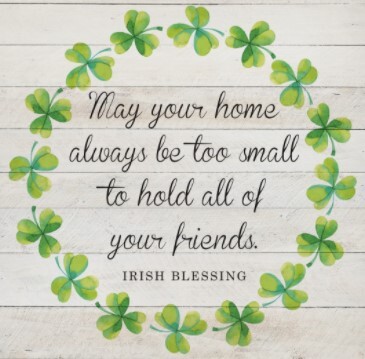
For more information on Ferguson Falls and St. Patrick’s Roman Catholic Church: https://arlenestaffordwilson.wordpress.com/2012/07/06/st-patricks-church-fergusons-falls-lanark-county/
For Thomas Stafford’s account of the “Cattle Drives in Ferguson Falls” in “Lanark County Chronicle: Double Back to the Third Line”

For the legend of Jimmy Whelan, – “The Ghost of Ferguson Falls” – “Lanark County Calling: All Roads Lead Home”
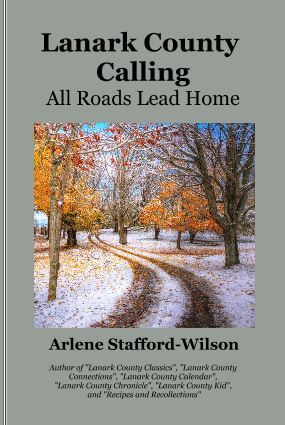
The story of “The Stumble Inn of Ferguson Falls”, from the book “Lanark County Collection”
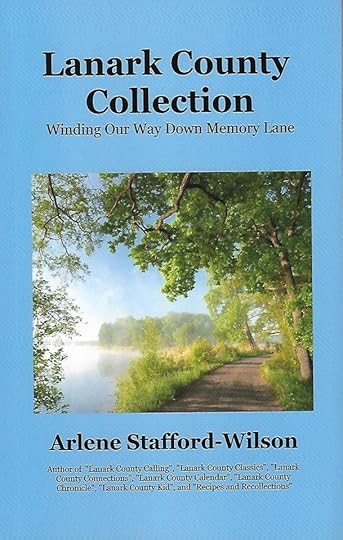
.
 Arlene Stafford-Wilson
Arlene Stafford-WilsonMember, Association of Professional Genealogists
Honorary Life Member, Lanark County Genealogical Society
Lanark County Pioneer Families Humanitarian Award
Francois Bregha Storyteller Award
Heritage Perth Architectural Conservation Award
Author of : “Lanark County Christmas”, “Lanark County Comfort”, “Lanark County Collection”, “Lanark County Calling”, “Lanark County Classics”, “Lanark County Connections”, “Lanark County Calendar”, “Lanark County Chronicle”, “Lanark County Kid”, & “Recipes & Recollections”, and “Lanark County Kitchen: A Maple Legacy from Tree to Table”, and “Lanark County Classrooms: Remembering Our School Days”.
August 13, 2025
White Church, Drummond Township
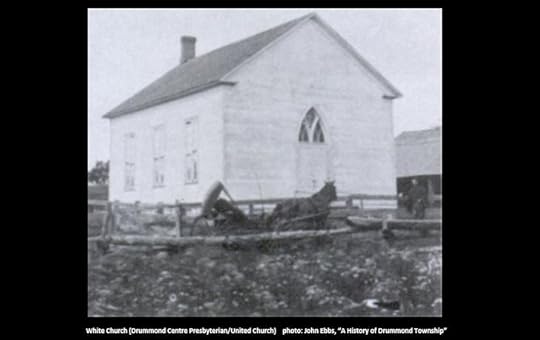
Drummond Centre Church
(also known as White Church)
With transportation being so quick and easy in the modern world it’s difficult for us to imagine that the early pioneer settlers often had to walk from place to place, as not everyone was fortunate enough to own a horse and buggy. They walked to obtain dry goods for cooking and baking, they walked from farm to farm for social events, birthday celebrations, and to visit with neighbours. They also walked to the closest church so they could carry on with the religious practices and beliefs that they brought with them from the old country.
There was a growing group of mostly Scottish, mostly Presbyterian pioneers who had settled in the Drummond Centre area, and in the early days, many of this hardy lot had to walk to Perth to attend church at Knox Presbyterian Church. While walking to Perth was not as much of a difficulty for the younger and healthier members of the community, it was not the case for the elderly, or those who were in the later stages of expecting a child, or for anyone for whatever reason was not physically capable of walking that far. Some of the more prosperous farmers went to Perth on horseback, and a smaller number, more affluent, used horse and buggy, or horse and cutter in the winter.
Duncan McLaren
Duncan McLaren, a respected member of the Presbyterian community, and an Elder at Knox Church, in Perth, was chosen by members of the congregation from Drummond Centre, to visit the Presbytery in Brockville. They were the body responsible for administering the churches in their region. His request was for permission for the people in Drummond Centre to be able to establish a branch of the Presbyterian Church right in their own community.
First Service in 1881
While two mission ‘fields’ were granted in 1877, one at Balderson, and one at Drummond Centre, it was not until 1881 that the new Drummond Centre Presbyterian Church was built and opened. The church was built on the East half of Lot 17, on Concession 8, of Drummond Township. James Stewart sold a quarter acre of land to the church for the sum of one dollar. The deed was signed by Adam Armstrong, James Shaw, and Henry McDonald.
Anniversary Services were held in the fall of 1920:
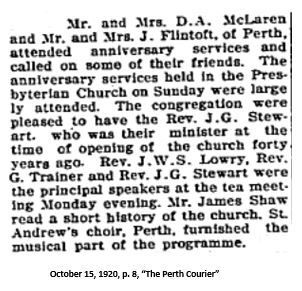
Drummond Centre
United Church
In 1925, with the amalgamation of some of the Presbyterian, Methodist, and United Churches, the Drummond Centre Presbyterian Church became part of the United Church of Canada.
50th Anniversary
On October 26th, 1931, Drummond Centre United Church celebrated their 50th anniversary. An article from “The Perth Courier” provides details of the event, and gives the reader an insight into those times, so long ago:

(transcribed from “The Perth Courier”, October 30, 1931, p. 1)
“This important and most unique event in connection with the Drummond Centre United Church was solemnized and duly celebrated upon Sabbath, October 26th, 1931. Special anniversary services were held morning and evening, the speaker for the day being the minister of the church, rev. Thomas McNaught, B.D., of Balderson. The church was filled to an overflowing capacity at both services, as many former members were present and friends from neighboring communities. Beautiful fall weather prevailed.
“The church was filled to an overflowing capacity at both services, as many former members were present and friends from neighboring communities. Beautiful fall weather prevailed.”
In the morning the service of Praise was in charge of members from St. Andrew’s Presbyterian Church choir, Perth, consisting of aquartetto, Messrs. Dodds, Steele, Howie, and Kerr. Mrs. Kerr presided at the organ. They were assisted by members from the Balderson and Prestonvale choir. Mr. Fred Steele sang a most appropriate solo, ‘Building for Eternity’ which was listened to not only with a sense of joy but of spiritual profit. Then the quartette rendered in a most soul stirring manner that beautiful piece entitled, ‘Jesus, Savior, Pilot Me’. Rev. Mr. McNaught spoke from the text found in 1st Cor. 4:18 and in the words of this text and throughout his sermon he sought not only to show the vast different between the temperal and the spiritual – the transient and the eternal but urged upon his hearers to build upon the eternal verities of the Eternal God and His eternal truth and not to forget the spiritual welfare of their inner and higher life that man cannot live by bread alone but by every word that proceeded out of the mouth of God.
“Mrs. Kerr presided at the organ. They were assisted by members from the Balderson and Prestonvale choirs.”
At the close of the service Mr. McNaught in a few well chosen words thanked the friends from Perth who had taken charge of the service of praise and who had brought such inspiring and helpful messages through the medium of service song. He also expressed the congregation’s thanks to the members of the Balderson and Prestonvale choirs who had assisted.
In the evening a still larger congregation was present. The service of Praise was in charge of the Prestonvale choir. This fine choir was out in full strength and was greatly helped by friends from Perth.
This splended choir led the congregation in its singing a solo, ‘When I Survey the Wondrous Cross’, sung by Mr. Rodney. All listened to it with deep appreciation and a feeling that it brought a wonderful message to all the worshippers assembled. Then a quartette was rendered by Messrs. Reid, McLaren, Rodney and Couch, the selection being, ‘Rock of Ages’, and later the entire choir sang an anthem conveying the old Gospel message in sacred song. At the close of the evening service Mr. McNaughton thanked the Prestonvale choir and organist and the friends from Perth who had assisted them in the name of the congregation assuring them of their sincere thanks and appreciation.
“Before closing the evening service he asked all present to stand who were present fifty years ago at the opening and dedication of the church. Only seven were present who witnessed the opening and dedication of the church.”
Mr. McNaught’s message was entitled, “The Call of Christ”, basing his sermon upon Christ’s words, ‘Follow Me’, recorded in St. Matthew 4:19. His message was a call for all to hear Christ’s call for Christian service and to surrender their all to Him. Before closing the evening service he asked all present to stand who were present fifty years ago at the opening and dedication of the church. Only seven were present who witnessed the opening and dedication of the church.”
“On Monday evening a social time was spent together in the Orange Hall.”
(the L.O.L. # 7 Orange Lodge, one of the earliest established in the country, was located near the church)
“On Monday evening a social time was spent together in the Orange Hall, the hall being put at the disposal of the Church by the local Orangemen for the evening gratuitously which was greatly appreciated by the congregation. There was a large turnout and a fine mixed program was gone through and listened to with much enjoyment and also profit. Some young people from Carleton Place put on very effectively a pantomime entitled, ‘The Lamp Went Out’. Miss Anderson sang beautifully a solo while Miss Brunton of Balderson was the elocutionist of the evening and was heard several times through the evening with great delight to all.
The school children of Drummond Centre under the leadership of Mr. Devy of Perth, put on several numbers which were greatly enjoyed. Then a beautiful drill was gone through in a faultless manner by the girls of the school under the guidance of their teacher Mrs. Horrocks.
“After this, refreshments were served and an enjoyable social time was spent by all.”
The speeches for the evening were three – Rev. Mr. Livesay, returned missionary from Korea brought a wonderful message telling in vivid language the work of the Church in Korea. He was followed by Rev. Dr. James Semple of Smiths Falls and as chairman of the Renfrew Presbytery brought the Presbytery’s greetings to the congregation upon this the occasion of their golden jubilee. He too brought a wonderful message urging upon the congregation to ever emphasize the essential things of our Christian faith. He referred to the very fine friendship existing between him and their pastor, Mr. McNaught – that not only were they college chums but had graduated the same year. Inspector T.C. Smith, M.A. was also heard in a short address of congratulations to minister and people and a few words of Christian counsel. Mr. McNaught was chairman and welcomed all present. The first part of the evening was brought to a close by the chairman thanking all in the name of the congregation who had assisted in the program and by the entire audience rising and singing the National Anthem. After this, refreshments were served and an enjoyable social time was spent by all.
Church History
Some details of the rich history of the church were also provided in the article from, “The Perth Courier”, dated October 30, 1931:
“A brief history of this congregation might be interesting. Drummond Centre community was largely settled by pioneers from Scotland over 100 years ago – their spiritual interests were not forgotten and they realized the need of God in their lives. The following extract was read and prepared by the late Mr. James Shaw at the 40th Anniversary and taken from a local paper, October 14th, 1920:
“In the pioneer days in Drummond Township many of the earlier settlers had to drive a considerable distance to Knox Church, Perth. As many of these settlers had come from Scotland, a land where the ordinances of divine grace were faithfully attended, the people felt they must have in their own community some visible sign of Jehovah’s presence. To this end Mr. Duncan McLaren, an elder of Knox Church, Perth, was chosen to appeal to the Brockville Presbytery for permission to form a congregation. After some discussion Presbytery granted the request and steps were taken to form a congregation in connection with Balderson, an outshot from St. Andrew’s, Perth.
“As many of these settlers had come from Scotland, a land where the ordinances of divine grace were faithfully attended…”
In 1877, mission fields were formed in the congregations with Mr. J.K. Baillie as the first missionary, who remained among us for two summers. Mr. Baillie was followed by Mr. John Geddes, who labored for a year and a half, after which he returned to Scotland.
The two missions were established as one congregation in the summer of 1880 and called Rev. J.G. Stuart as minister, who was inducted into the charge in October, 1880. His salary was $400 supplemented by $200 from the Mission Board. During his ministry of over nine years he endeared himself to the congregation especially in the Sabbath School and among the young. In December 1889, he resigned, being called to St. Mark’s Church, Toronto.
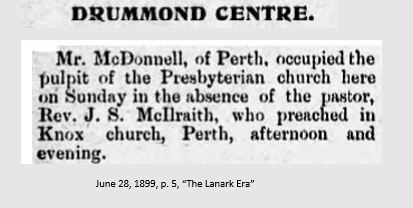
Then a few months afterwards a call was extended to Rev. J.S. McIlraith, of Montreal College and in the spring of 1890 he was inducted. He labored amongst us for almost twenty-one years doing faithful work especially visiting the sick and the aged. He resigned in the summer of 1911 and was followed by Rev. J.G. Greig.
Rev. J.G. Greig was inducted in the autumn of 1911 and ministered to us almost eight years. He too gave us faithful and practical sermons which if we lived out in our daily lives would make us more Christlike in character. In the autumn of 1919 Mr. Greig accepted a call to Valleyfield, Quebec. At the close of his ministry the missionary givings amounted to $1,722.00 and the minister’s stipend to $1,400.00, there having been a gradual increase in the givings from the congregation to the present date. After being several months without a settled minister a call was extended to Rev. G.C. Treanor and accepted trusting that the ministry will be as successful as those who preceded him.
“He too gave us faithful and practical sermons which if we lived out in our daily lives would make us more Christlike in character.”
In the fall of 1922 Mr. Treanor resigned, having accepted a call to Arthur and Goodville in the Saugeen Presbytery.
In March, 1923, a unanimous call was given to Rev. R.A. McRae, B.A., a recent graduate of the Montreal Presbyterian College. He was ordained and inducted in the Balderson Church in March 1923. He did faithful and conscientious work, and resigned in 1927, and is now laboring at Minden, Ontario. During his pastorate the charge passed into the United Church.
In 1925, the Drummond Centre Presbyterian Church became part of the United Church of Canada, and so, was re-named, the Drummond Centre United Church.
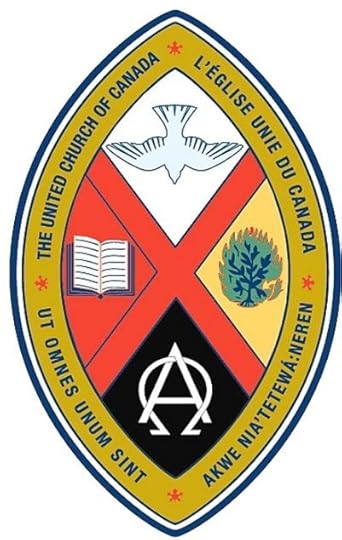
(The United Church of Canada was formed 10 June 1925 by the union of some, but not all, of the Presbyterian Churches in Canada, with the Methodist Church, the Congregational Churches of Canada, and the General Council of Local Union Churches.)
“Rev. C.M. Currie, M.A., B.D., then became pastor having received a call and did faithful work until he resigned in the year 1930 in order that he might pursue a post graduate course in New College, Edinburgh, Scotland, for his Ph.D. degree. Before leaving for Scotland he was married to Miss Edith McTavish, of Balderson. Recently, he has been called and accepted same to be assistant minister of Connorgate Church, Edinburgh, Scotland. In the summer of 1930, Rev. Thomas McNaught, B.D., of White Lake, became pastor pursuant to an unanimous call being extended to him and he was inducted on the evening of July 4th, 1930.
“The organizers of the Church in Drummond were: Duncan McLaren, James Shaw, and James Stewart.”
A few items might be interesting re the Drummond Centre Church. The organizers of the Church in Drummond were Messrs. Duncan McLaren, James Shaw, and James Stewart. Mrs. Stewart deeded the land for the church. Rev. Wm. Burns of Knox Church, Perth, conducted the opening services and preached. The first preacher in the church was the late Mr. Adam Young, followed by the late Mr. John Hillis, who was followed by the late Mrs. Wesley Clarke and he in turn was succeeded by Mr. D.A. McLaren and later by Mr. Wm. McFarlane, now of Prestonvale.
The elders now at Drummond are Messrs. Wm. McLaren, Dan Malloch, J.B. Miller and Wilbert Lewis, and the Managers are Messrs. Homer Shaw, James McLaren and John McNaughton.”
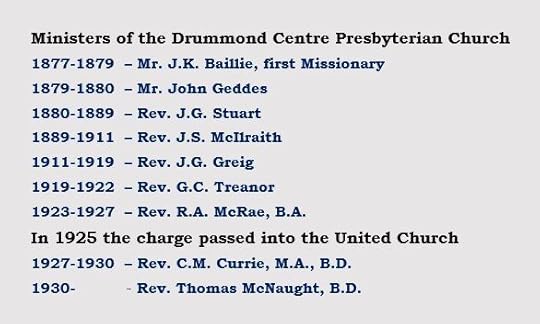
Rev. Thomas McNaught

Minister at Drummond Centre United Church, beginning in 1930
Anniversary Services
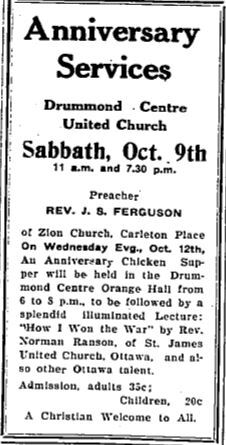
Oct. 7, 1932, p. 5, “The Perth Courier”
Mother’s Day Service
In the spring of 1933, a special Mother’s Day Service was held at Drummond Centre United Church:
“Miss (Mary) Malloch some time ago received a Bible from her pastor for having recited correctly at one sitting the entire 119th Psalm.”
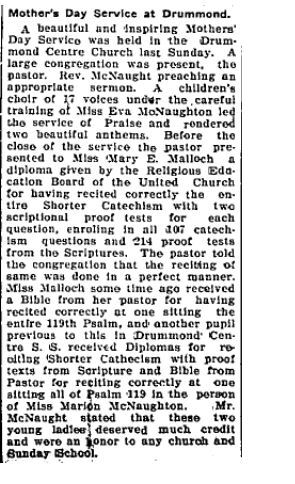
May 19, 1933, p. 1, “The Perth Courier”
Church Closes
The Drummond Centre United Church closed its doors in 1951, and the remaining members of the congregation joined either St. Paul’s United Church, in Perth, Ontario, or the United Church at Boyd’s Settlement.
Church Sold
After the church closed, the building and land was sold to a Mr. Probert, from Carleton Place, Ontario. Mr. Probert owned the property for 21 years, then sold it in 1971 to Clifford Ebbs, who moved the building a short distance south on Gardiner Road to a building lot.
(This is the house directly across Gardner Rd from the E. corner of the Drummond Center Community Cemetery)
The church was sold to Keith Mordy in 1973, and the building was converted to a duplex.
The Cemetery

Along with the land donated by James Stewart for the church, James McLaren donated land for a ‘burying ground’, nearby, which is now called the Drummond Centre Community Cemetery.
This cemetery was used as a ‘burying ground’, from as early as the late 1820s or early 1830s. In November 26, 1858, he property was transferred by James and his wife, Christina McLaren, to the Trustees on behalf of the Presbyterian Church of Canada.
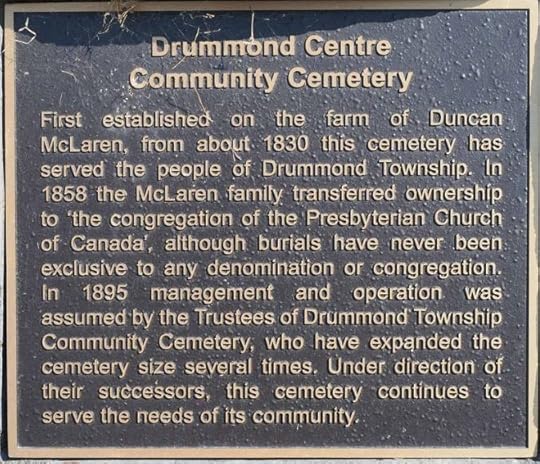
The connection to the Presbyterian Church was severed in May 1895, and it became a “community” cemetery, with the first community trustees being James and his wife, Janet Stewart, John Malloch, and James Shaw.
(Note: descendants of the same families continue to serve as trustees today.)
Surnames in the cemetery:
ALLEN, ARMSTRONG, BARROWMAN, BENEDICT, BEUREGARD, BULLIS, CAMPBELL, CASWELL, CLARK, COOKE, CUNNINGHAM, DEVLIN, FERGUSON, FLINTOFF, FLINTOFT, GREENLEY, HAIG, HALL, HATCH, HORLER, HORRICKS, IRETON, IRVINE, KEYES, KEYS, KIRKHAM, LEWIS, MALLOCH, MCCOY, MCCULLOUGH, MCDONALD, MCEWEN, MCGREGOR, MCLAREN, MCLEAN, MCNAUGHTON, MCPHAIL, MCPHERSON, MORIS, MORRIS, MORROW, MOULTON, OATES, PALMER, POWERS, RICHMOND, ROBERTSON, SCHOOTEN, SHAIL, SHAW, STEEN, STEWART, TYSICK, WHITE, WILLOWS, WOOLSEY, YOUNG, YUILL
Orange Lodge L.O.L. # 7
One of the earliest lodges of the Protestant group, the Orange Order, was built close to the church, and the space was often donated by the Lodge for use by the church members for their clubs, and activities. The land was ‘sold’ to the Loyal Orange Order in 1903, by Nathaniel Caswell for $1.00.
Today
…..And so today, we wonder why the little white church on Gardiner Road closed in 1951? Was it because the community was more mobile, with access to automobiles, and they preferred to attend a larger more stately church, like St. Paul’s United, in Perth? Did the maintenance become too expensive on the small church built so many years before? Could it be that an old church lacked a good heating system for those cold winter days in Eastern Ontario, or adequate cooling on the equally hot and humid dog-days of summer?
There is no longer any sign of the Orange Hall, #7 L.O.L, that served the members of the community in those early days. The members from that old lodge eventually joined another nearby.
The cemetery remains, and the names on the oldest stones tell a story of those early Scottish pioneers who settled in Drummond Centre. In an unbroken chain of loyalty and sense of duty, descendants of those original stewards of the cemetery still maintain it to this day, walking the grounds where their ancestors walked, guarding the memories of the little white church and its people, who came to this pretty community, so long ago.
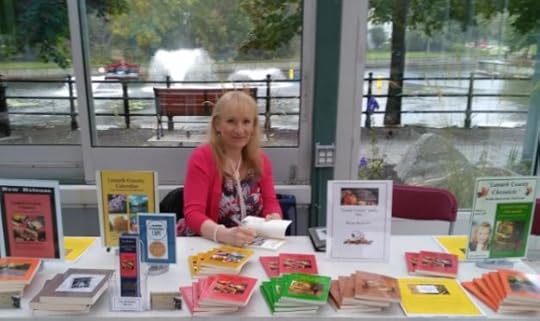
Arlene Stafford-Wilson
Member, Association of Professional Genealogists
Honorary Life Member, Lanark County Genealogical Society
Lanark County Pioneer Families Humanitarian Award 2023
Francois Bregha Storyteller Award
Heritage Perth Architectural Conservation Award
Author of : “Lanark County Christmas”, “Lanark County Comfort”, “Lanark County Collection”, “Lanark County Calling”, “Lanark County Classics”, “Lanark County Connections”, “Lanark County Calendar”, “Lanark County Chronicle”, “Lanark County Kid”, & “Recipes & Recollections”, “Lanark County Kitchen: A Maple Legacy from Tree to Table”, “Lanark County Classrooms: Remembering Our School Days.”
August 7, 2025
‘Witching’ or ‘Dowsing’ for Water
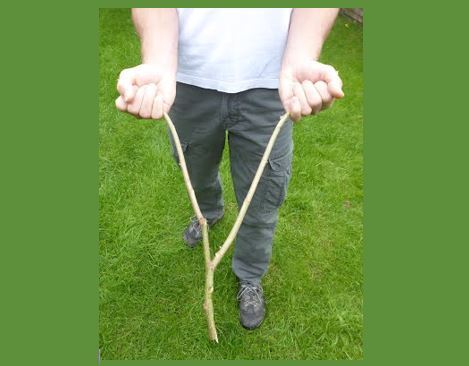
I often wonder what went through our Mother’s mind, when Dad informed her that there was no indoor plumbing in the farmhouse, on the Third Line of Bathurst, where they would be living, after the war.
They purchased the farm from Dad’s aunt and uncle, partly with the help of a Veteran’s Grant, in 1946, when Dad returned from overseas.
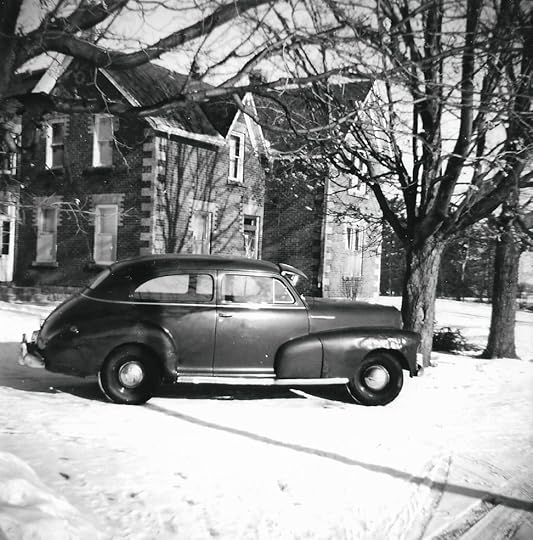
With two babies in diapers, I can’t imagine that my Mother was very happy at the prospect of drawing water from a well, with a hand-pump, a hundred yards from the house. There was a big cement cistern in the basement as well, which collected rain water, but that was just for washing, not drinking.
Water was often in short supply, and almost every year by summer’s end, the well was running dry. When Dad worked for Chaplin’s Dairy, in Glen Tay, he brought water home from the dairy at night, in big metal milk cans, to hold us over, for a while.
Drilling a well was an expensive project to undertake. People paid by the foot, and we’d all heard the horror stories about a neighbour or acquaintance, who had paid for drilling but had not ‘hit’ water in the process.
The practice in those days, back in the 1950s and 1960s, was to hire a ‘Switcher’, or ‘Diviner’, who would walk the property, and use a method called ‘Dowsing’. In fact, this was such a common practice at the time that I recall this technique being called by a few different names: Witching, Switching, and Divining, depending on who you were talking to.
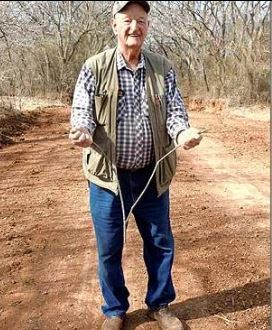
In many cases, a drilling company either had someone on staff, or knew a person with this skill, and brought them along to assist in finding the best spot to drill, where the water was closest to the surface.

The Thompson brothers, Jerry and Connie drilled our well, and they hired Jack Dowdall from Glen Tay, to walk the land with the apple branch to detect the water.
“I remember when a new well was drilled, and when the men came with the dowsing stick. I can’t recall when they called it – I think a divining stick or rod, but it was used to find water.
I was there, and asked if I could try it. The men seemed amused, but he told me what to do. I can’t remember if I felt anything or not, but when he found the water, it seemed to pull him and the stick almost down to the ground.”
Jackie Stafford WhartonI recall in those days they used a willow branch, or apple branch, and fashioned it so that it had two short ends, and one long end. Willow or apple was used to create the strongest ‘pull’ to the water. I’ve also heard that peach branches, or hazel branches conduct water in the same way.

The practice of dowsing, goes back to the 15th century in Europe, where it was used not only to find water, but to detect metals as well.
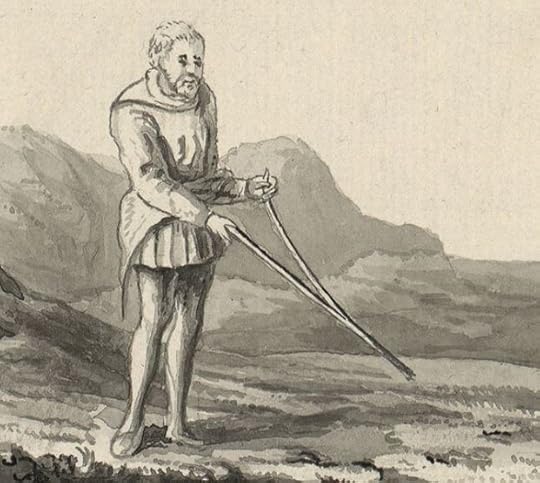
Dowsing or Witching was used extensively during the building of the railroad across Canada, to find drinking water for the crew, along the route.
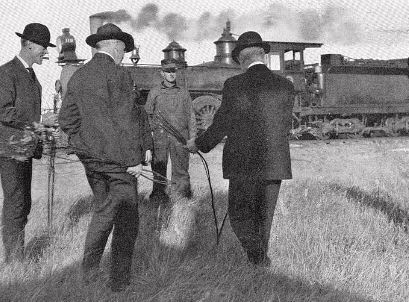
Farmers have used water-witching for generations, to determine the best place to dig their wells, and to find a source of drinking water for their cattle in a pasture.
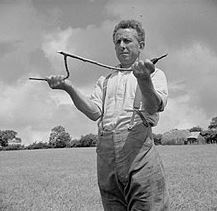
The practice continues to be used today, in some cities in Canada. Metal rods are used instead of the old-fashioned tree branches.
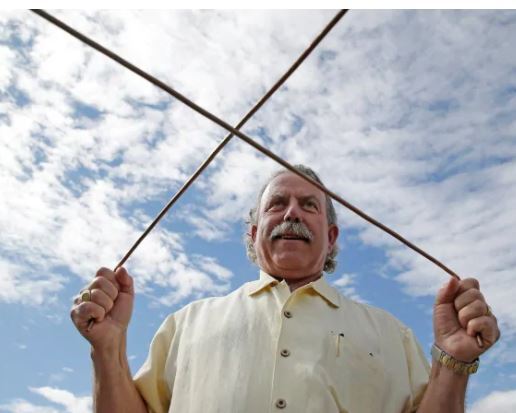
“The city (Ottawa) says it still routinely uses the age-old detection technique, also known as dowsing or water witching.
“Definitely the other technology works more consistently,” said Quentin Levesque, manager of what’s known as the city’s “locates group.”
“Should they have difficulties or troubles using the other equipment, the divining rod is there as well.”
The practice involves walking slowly over an area while holding one of the L-shaped rods in each hand. When the two rods cross, that’s supposed to signify the diviner is standing over water.”
Some Call it ‘A Gift’Can anyone use divining rods, or a willow switch to find water?
Some say it is a gift, and only those with this natural, intuitive, sensing ability can detect water. Some say that it doesn’t necessarily pass from father to son, or down through the family.
Some people claim that dowsing is a psychic ability, and some scoff and say that it is a learned ability, and that anyone can be trained to do it.
Whether it’s a gift, or something that can be learned, it’s still being practiced today by some, to pinpoint sources of water.
Were my parents happy when the well-witcher located the water in our yard, and the Thompson brothers drilled our well? They sure were!
Was it mystical or magical or other-worldly, when our Mother turned on the tap in the old house, and drinking water gushed out for the first time?
I’m sure to her, it was.
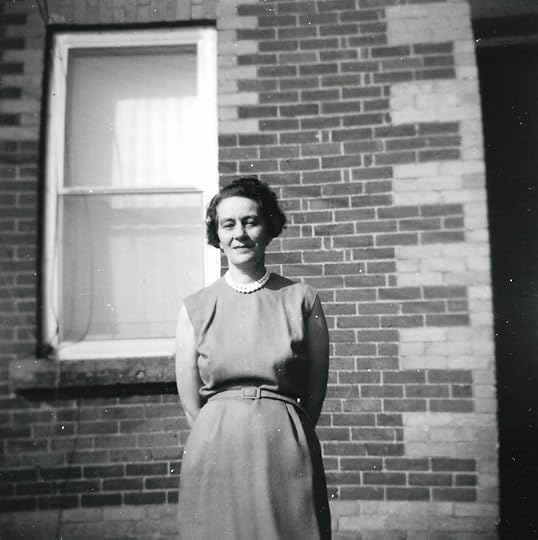
Jerry Thompson’s siblings: Vera (Percy Wills), Gordenia (Winfred Truelove), Marie (Maurice Wills), Gwen (Frank Turnbull), Connell ‘Connie’ (Phyllis North) Thompson, and Murray (Roberta Livingstone)Thompson.
Jack Dowdall’s siblings: Elizabeth (Clarence Donaldson), Violet (Lawrence Dixon), Lillian (William Kirkham), Laura ( Peter Kirkham), Edna (Joseph Kirkham), Mae (James McLaren), Edward (Mildred Foshay), Garnet (Margaret Stewart), William (Eleanor Gordon), George (Pearl Gordon), and Frank (Carmel Kirkham).
‘Meet’ Jerry, Connie and Jack, as they find the best spot to dig a country well, in the story: “Mysterious Ways of the Water Witcher”,
featured in the book – “Lanark County Collection” ISBN 978-0987-7026-78
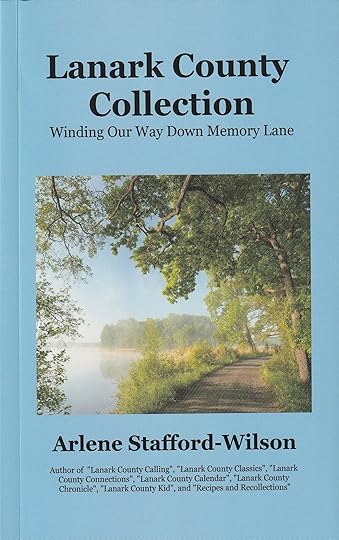
* * *
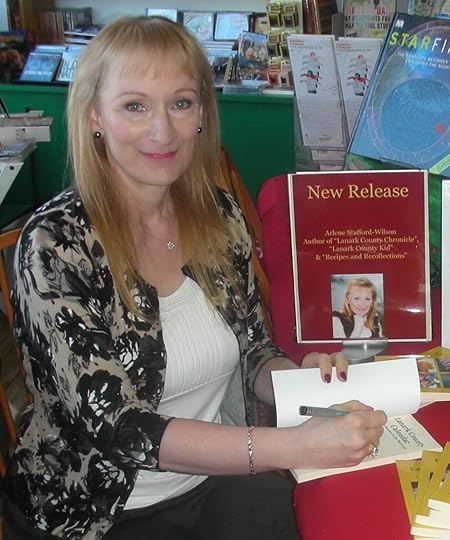
Arlene Stafford-Wilson
Member, Association of Professional GenealogistsHonorary Life Member, Lanark County Genealogical SocietyLanark County Pioneer Families Humanitarian AwardFrancois Bregha Storyteller AwardHeritage Perth Architectural Conservation AwardAuthor of : “Lanark County Christmas”, “Lanark County Comfort”, “Lanark County Collection”, “Lanark County Calling”, “Lanark County Classics”, “Lanark County Connections”, “Lanark County Calendar”, “Lanark County Chronicle”, “Lanark County Kid”, & “Recipes & Recollections”, and “Lanark County Kitchen: A Maple Legacy from Tree to Table”, and “Lanark County Classrooms: Remembering Our School Days.”
